4.1: The Role of Socialization
4.1.1: The Role of Socialization
Socialization prepares people for social life by teaching them a group’s shared norms, values, beliefs, and behaviors.
Learning Objective
Describe the three goals of socialization and why each is important
Key Points
- Socialization prepares people to participate in a social group by teaching them its norms and expectations.
- Socialization has three primary goals: teaching impulse control and developing a conscience, preparing people to perform certain social roles, and cultivating shared sources of meaning and value.
- Socialization is culturally specific, but this does not mean certain cultures are better or worse than others.
Key Terms
- Jeffrey J. Arnett
-
In his 1995 paper, “Broad and Narrow Socialization: The Family in the Context of a Cultural Theory,” sociologist Jeffrey J. Arnett outlined his interpretation of the three primary goals of socialization.
- socialization
-
The process of learning one’s culture and how to live within it.
- norm
-
A rule that is enforced by members of a community.
Example
- The belief that killing is immoral is an American norm, learned through socialization. As children grow up, they are exposed to social cues that foster this norm, and they begin to form a conscience composed of this and other norms.
The role of socialization is to acquaint individuals with the norms of a given social group or society. It prepares individuals to participate in a group by illustrating the expectations of that group.
Socialization is very important for children, who begin the process at home with family, and continue it at school. They are taught what will be expected of them as they mature and become full members of society. Socialization is also important for adults who join new social groups. Broadly defined, it is the process of transferring norms, values, beliefs, and behaviors to future group members.
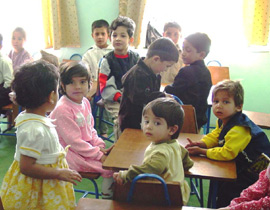
Socialization in School
Schools, such as this kindergarten in Afghanistan, serve as primary sites of socialization.
Three Goals of Socialization
In his 1995 paper, “Broad and Narrow Socialization: The Family in the Context of a Cultural Theory,” sociologist Jeffrey J. Arnett outlined his interpretation of the three primary goals of socialization. First, socialization teaches impulse control and helps individuals develop a conscience. This first goal is accomplished naturally: as people grow up within a particular society, they pick up on the expectations of those around them and internalize these expectations to moderate their impulses and develop a conscience. Second, socialization teaches individuals how to prepare for and perform certain social roles—occupational roles, gender roles, and the roles of institutions such as marriage and parenthood. Third, socialization cultivates shared sources of meaning and value. Through socialization, people learn to identify what is important and valued within a particular culture.
The term “socialization” refers to a general process, but socialization always takes place in specific contexts. Socialization is culturally specific: people in different cultures are socialized differently, to hold different beliefs and values, and to behave in different ways. Sociologists try to understand socialization, but they do not rank different schemes of socialization as good or bad; they study practices of socialization to determine why people behave the way that they do.
4.1.2: Nature vs. Nurture: A False Debate
Is nature (an individual’s innate qualities) or nurture (personal experience) more important in determining physical and behavioral traits?
Learning Objective
Discuss both sides of the nature versus nurture debate, understanding the implications of each
Key Points
- Nature refers to innate qualities like human nature or genetics.
- Nurture refers to care given to children by parents or, more broadly, to environmental influences such as media and marketing.
- The nature versus nurture debate raises philosophical questions about determinism and free will.
Key Terms
- determinism
-
The doctrine that all actions are determined by the current state and immutable laws of the universe, with no possibility of choice.
- nature
-
The innate characteristics of a thing. What something will tend by its own constitution, to be or do. Distinct from what might be expected or intended.
- nurture
-
The environmental influences that contribute to the development of an individual; see also nature.
Example
- Recently, the nature versus nurture debate has entered the realm of law and criminal defense. In some cases, lawyers for violent offenders have argued that criminal activity is caused by nature -that is, by genes, rather than rational decision-making processes. Such arguments may suggest that the accused are less culpable for their crimes. A “genetic predisposition to violence” could be a mitigating factor in crime if the science behind genetic determinants can be found conclusive. “Nurture”-based explanations, such as a disadvantaged background, have in some cases already been accepted as mitigating factors.
The nature versus nurture debate rages over whether an individual’s innate qualities or personal experiences are more important in determining physical and behavioral traits .
In the social and political sciences, the nature versus nurture debate may be compared with the structure versus agency debate, a similar discussion over whether social structure or individual agency (choice or free will) is more important for determining individual and social outcomes.
Historically, the “nurture” in the nature versus nurture debate has referred to the care parents give to children. But today, the concept of nurture has expanded to refer to any environmental factor – which may arise from prenatal, parental, extended family, or peer experiences, or even from media, marketing, and socioeconomic status. Environmental factors could begin to influence development even before it begins: a substantial amount of individual variation might be traced back to environmental influences that affect prenatal development.
The “nature” in the nature versus nurture debate generally refers to innate qualities. In historical terms, nature might refer to human nature or the soul. In modern scientific terms, it may refer to genetic makeup and biological traits . For example, researchers have long studied twins to determine the influence of biology on personality traits. These studies have revealed that twins, raised separately, still share many common personality traits, lending credibility to the nature side of the debate. However, sample sizes are usually small, so generalization of the results must be done with caution.
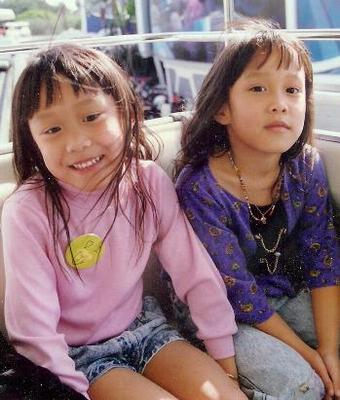
Identical Twins
Because of their identical genetic makeup, twins are used in many studies to assess the nature versus nurture debate.
The nature versus nurture debate conjures deep philosophical questions about free will and determinism. The “nature” side may be criticized for implying that we behave in ways in which we are naturally inclined, rather than in ways we choose. Similarly, the “nurture” side may be criticized for implying that we behave in ways determined by our environment, not ourselves.
Of course, sociologists point out that our environment is, at least in part, a social creation.
4.1.3: Sociobiology
Sociobiology examines and explains social behavior based on biological evolution.
Learning Objective
Discuss the concept of sociobiology in relation to natural selection and Charles Darwin, as well as genetics and instinctive behaviors
Key Points
- Sociobiologists believe that human behavior, like nonhuman animal behavior, can be partly explained as the outcome of natural selection.
- Sociobiologists are interested in instinctive, or intuitive behavior, and in explaining the similarities, rather than the differences, between cultures.
- Many critics draw an intellectual link between sociobiology and biological determinism, the belief that most human differences can be traced to specific genes rather than differences in culture or social environments.
Key Terms
- natural selection
-
A process by which heritable traits conferring survival and reproductive advantage to individuals, or related individuals, tend to be passed on to succeeding generations and become more frequent in a population, whereas other less favorable traits tend to become eliminated.
- biological determinism
-
The hypothesis that biological factors such as an organism’s genes (as opposed to social or environmental factors) determine psychological and behavioral traits.
- sociobiology
-
The science that applies the principles of evolutionary biology to the study of social behavior in both humans and animals.
Example
- A sociobiological explanation of humans running might argue that human beings are good at running because our bodies have evolved to run bipedally. In the course of human evolution, we had to run away from predators. Those who had the genetic makeup to be effective runners survived and passed along their genes, while those lacking the genetic predisposition for running were killed by predators.
Sociobiology is a field of scientific study which is based on the assumption that social behavior has resulted from evolution. It attempts to explain and examine social behavior within that context. Often considered a branch of biology and sociology, it also draws from ethology, anthropology, evolution, zoology, archaeology, population genetics, and other disciplines. Within the study of human societies, sociobiology is very closely allied to the fields of Darwinian anthropology, human behavioral ecology, and evolutionary psychology. While the term “sociobiology” can be traced to the 1940s, the concept didn’t gain major recognition until 1975 with the publication of Edward O. Wilson’s book, Sociobiology: The New Synthesis .

Edward O. Wilson
E. O. Wilson is a central figure in the history of sociobiology.
Sociobiologists believe that human behavior, like nonhuman animal behavior, can be partly explained as the outcome of natural selection. They contend that in order to fully understand behavior, it must be analyzed in terms of evolutionary considerations. Natural selection is fundamental to evolutionary theory. Variants of hereditary traits, which increase an organism’s ability to survive and reproduce, are more likely to be passed on to subsequent generations. Thus, inherited behavioral mechanisms that allowed an organism a greater chance of surviving and reproducing in the past are more likely to survive in present organisms.
Following this evolutionary logic, sociobiologists are interested in how behavior can be explained as a result of selective pressures in the history of a species. Thus, they are often interested in instinctive, or intuitive behavior, and in explaining the similarities, rather than the differences, between cultures. Sociobiologists reason that common behaviors likely evolved over time because they made individuals who exhibited those behaviors more likely to survive and reproduce.
Many critics draw an intellectual link between sociobiology and biological determinism, the belief that most human differences can be traced to specific genes rather than differences in culture or social environments. Critics also see parallels between sociobiology and biological determinism as a philosophy underlying the social Darwinian and eugenics movements of the early 20th century as well as controversies in the history of intelligence testing.
4.1.4: Deprivation and Development
Social deprivation, or prevention from culturally normal interaction with society, affects mental health and impairs child development.
Learning Objective
Explain why social deprivation is problematic for a person (especially children) and the issues it can lead to
Key Points
- As they develop, humans go through several critical periods, or windows of time during which they need to experience particular environmental stimuli in order to develop properly.
- Feral children provide an example of the effects of severe social deprivation during critical developmental periods.
- Attachment theory argues that infants must develop stable, on-going relationships with at least one adult caregiver in order to form a basis for successful development.
- The term maternal deprivation is a catch phrase summarizing the early work of psychiatrist and psychoanalyst John Bowlby on the effects of separating infants and young children from their mother.
- In United States law, the “tender years” doctrine was long applied when custody of infants and toddlers was preferentially given to mothers.
Key Terms
- Attachment Theory
-
Attachment theory describes the dynamics of long-term relationships between humans. Its most important tenet is that an infant needs to develop a relationship with at least one primary caregiver for social and emotional development to occur normally.
- feral children
-
A feral child is a human child who has lived isolated from human contact from a very young age, and has no experience of human care, loving or social behavior, and, crucially, of human language.
- Social deprivation
-
In instances of social deprivation, particularly for children, social experiences tend to be less varied and development may be delayed or hindered.
Example
- Social deprivation theory has had implications for family law. “Tender years” laws in the United States are based on social attachment theories and social deprivation theories, especially the theory of maternal deprivation, developed by psychiatrist and psychoanalyst John Bowlby. Maternal deprivation theory explains the effects of separating infants and young children from their mother. The idea that separation from the female caregiver has profound effects is one with considerable resonance outside the conventional study of child development. In United States law, the “tender years” doctrine was long applied in child custody cases, and led courts to preferentially award custody of infants and toddlers to mothers.
Humans are social beings, and social interaction is essential to normal human development. Social deprivation occurs when an individual is deprived of culturally normal interaction with the rest of society. Certain groups of people are more likely to experience social deprivation. For example, social deprivation often occurs along with a broad network of correlated factors that all contribute to social exclusion; these factors include mental illness, poverty, poor education, and low socioeconomic status.
By observing and interviewing victims of social deprivation, research has provided an understanding of how social deprivation is linked to human development and mental illness. As they develop, humans pass through critical periods, or windows of time during which they need to experience particular environmental stimuli in order to develop properly. But when individuals experience social deprivation, they miss those critical periods. Thus, social deprivation may delay or hinder development, especially for children.
Feral children provide an example of the effects of severe social deprivation during critical developmental periods. Feral children are children who grow up without social interaction. In some cases, they may have been abandoned early in childhood and grown up in the wilderness. In other cases, they may have been abused by parents who kept them isolated from other people. In several recorded cases, feral children failed to develop language skills, had only limited social understanding, and could not be rehabilitated.
Attachment theory may explain why social deprivation has such dire effects for children . According to attachment theory, an infant needs to develop a relationship with at least one primary caregiver for social and emotional development to occur normally.
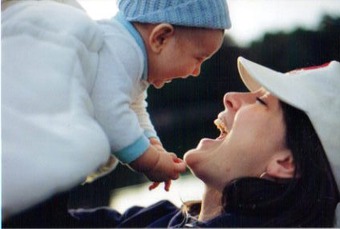
Maternal Deprivation
The idea that separation from the female caregiver has profound effects is one with considerable resonance outside the conventional study of child development.
4.1.5: Isolation and Development
Social isolation refers to a complete or near-complete lack of contact with society, which can affect all aspects of a person’s life.
Learning Objective
Interpret why social isolation can be problematic for a person in society and the importance of social connections
Key Points
- True social isolation is not the same as loneliness. It is often a chronic condition that persists for years and affects all aspects of a person’s existence.
- Emotional isolation is a term used to describe a state of isolation where the individual is emotionally isolated, but may have a well functioning social network.
- Social networks promote good health by providing direct support, encouraging healthy behaviors, and linking people with diffuse social networks that facilitate access to a wide range of resources supportive of health.
- Sociologists debate whether new technologies, such as the Internet and mobile phones, exacerbate social isolation or encourage it.
- A widely-held hypothesis is that social ties link people with diffuse social networks that facilitate access to a wide range of resources supportive of health.
Key Terms
- social isolation
-
Social isolation refers to a complete or near-complete lack of contact with society. It is usually involuntary, making it distinct from isolating tendencies or actions taken by an individual who is seeking to distance himself from society.
- emotional isolation
-
Emotional isolation is a term used to describe a state of isolation where the individual is emotionally isolated, but may have a well functioning social network.
- social network
-
The web of a person’s social, family, and business contacts, who provide material and social resources and opportunities.
Example
- Socially isolated individuals are more likely to experience negative health outcomes, such as failing to seek treatment for conditions before they become life-threatening. Individuals with vibrant social networks are more likely to encounter friends, family, or acquaintances who encourage them to visit the doctor to get a persistent cough checked out, whereas an isolated individual may allow the cough to progress until they experience serious difficulty breathing. Isolated individuals are also less likely to seek or get treatment for drug addiction or mental health problems, which they might be unable to recognize on their own. Older adults are especially prone to social isolation as their families and friends pass away.
Social isolation occurs when members of a social species (like humans) have complete or near-complete lack of contact with society. Social isolation is usually imposed involuntary, not chosen. Social isolation is not the same as loneliness rooted in temporary lack of contact with other humans, nor is it the same as isolating actions that might be consciously undertaken by an individual. A related phenomenon, emotional isolation may occur when individuals are emotionally isolated, even though they may have well-functioning social networks.
While loneliness is often fleeting, true social isolation often lasts for years or decades and tends to be a chronic condition that affects all aspects of a person’s existence and can have serious consequences for health and well being. Socially isolated people have no one to turn to in personal emergencies, no one to confide in during a crisis, and no one against whom to measure their own behavior against or from whom to learn etiquette or socially acceptable behavior. Social isolation can be problematic at any age, although it has different effects for different age groups (that is, social isolation for children may have different effects than social isolation for adults, although both age groups may experience it).
Social isolation can be dangerous because the vitality of individuals’ social relationships affect their health. Social contacts influence individuals’ behavior by encouraging health-promoting behaviors, such as adequate sleep, diet, exercise, and compliance with medical regimens or by discouraging health-damaging behaviors, such as smoking, excessive eating, alcohol consumption, or drug abuse. Socially isolated individuals lack these beneficial influences, as well as lacking a social support network that can provide help and comfort in times of stress and distress. Social relationships can also connect people with diffuse social networks that facilitate access to a wide range of resources supportive of health, such as medical referral networks, access to others dealing with similar problems, or opportunities to acquire needed resources via jobs, shopping, or financial institutions. These effects are different from receiving direct support from a friend; instead, they are based on the ties that close social ties provide to more distant connections.
Sociologists debate whether new technologies, such as the Internet and mobile phones exacerbate social isolation or could help overcome it. With the advent of online social networking communities, people have increasing options for engaging in social activities that do not require real-world physical interaction. Chat rooms, message boards, and other types of communities are now meeting social needs for those who would rather stay home alone, yet still develop communities of online friends.
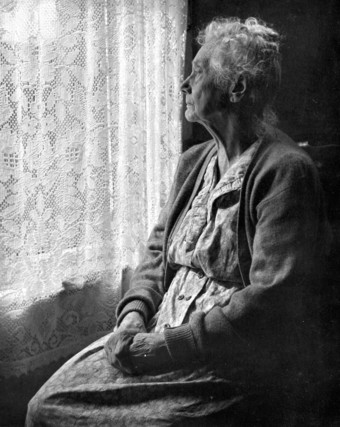
Social Isolation
Older adults are particularly susceptible to social isolation.
4.1.6: Feral Children
A feral child is a human child who has lived isolated from human contact from a very young age.
Learning Objective
Analyze the differences between the fictional and real-life depictions of feral children
Key Points
- Legendary and fictional feral children are often depicted as growing up with relatively normal human intelligence and skills and an innate sense of culture or civilization.
- In reality, feral children lack the basic social skills that are normally learned in the process of enculturation. They almost always have impaired language ability and mental function. These impairments highlight the role of socialization in human development.
- The impaired ability to learn language after having been isolated for so many years is often attributed to the existence of a critical period for language learning, and is taken as evidence in favor of the critical period hypothesis.
Key Terms
- critical period
-
A critical period refers to the window of time during which a human needs to experience a particular environmental stimulus in order for proper development to occur.
- enculturation
-
The process by which an individual adopts the behaviour patterns of the culture in which he or she is immersed.
- feral child
-
A child who is raised without human contact as a result of being abandoned, allegedly often raised by wild animals.
Example
- Peter Pan is a well-known example of a fictional feral child who is raised without adult supervision or assistance. Whereas Peter Pan’s upbringing is glorified, all real cases involve some form of serious child abuse.
A feral child is a human child who has lived isolated from human contact from a very young age, and has no (or little) experience of human care, loving or social behavior, and, crucially, of human language. Some feral children have been confined in isolation by other people, usually their own parents. In some cases, this child abandonment was due to the parents rejecting a child’s severe intellectual or physical impairment. Feral children may have experienced severe child abuse or trauma before being abandoned or running away.
Depictions of Feral Children
Myths, legends, and fictional stories have depicted feral children reared by wild animals such as wolves and bears. Legendary and fictional feral children are often depicted as growing up with relatively normal human intelligence and skills and an innate sense of culture or civilization, coupled with a healthy dose of survival instincts. Their integration into human society is also made to seem relatively easy. These mythical children are often depicted as having superior strength, intelligence, and morals compared to “normal” humans. The implication is that because of their upbringing they represent humanity in a pure and uncorrupted state, similar to the noble savage.
Feral Children in Reality
In reality, feral children lack the basic social skills that are normally learned in the process of enculturation. For example, they may be unable to learn to use a toilet, have trouble learning to walk upright, and display a complete lack of interest in the human activity around them. They often seem mentally impaired and have almost insurmountable trouble learning human language. The impaired ability to learn language after having been isolated for so many years is often attributed to the existence of a critical period for language learning at an early age, and is taken as evidence in favor of the critical period hypothesis. It is theorized that if language is not developed, at least to a degree, during this critical period, a child can never reach his or her full language potential. The fact that feral children lack these abilities pinpoints the role of socialization in human development.
Examples of Feral Children
Famous examples of feral children include Ibn Tufail’s Hayy, Ibn al-Nafis’ Kamil, Rudyard Kipling’s Mowgli, Edgar Rice Burroughs’ Tarzan, J. M. Barrie’s Peter Pan, and the legends of Atalanta, Enkidu and Romulus and Remus. Tragically, feral children are not just fictional. Several cases have been discovered in which caretakers brutally isolated their children and in doing so prevented normal development.
A real-life example of a feral child is Danielle Crockett, known as “The Girl in the Window”. The officer who found Danielle reported it was “the worst case of child neglect he had seen in 27 years”. Doctors and therapists diagnosed Danielle with environmental autism, yet she was still adopted by Bernie and Diane Lierow. Danielle could not speak or respond to others nor eat solid food. Today, Danielle lives in Tennessee with her parents and has made remarkable progress. She communicates through the PECS system and loves to swim and ride horses.

Peter Pan
Peter Pan is an example of a fictional feral child.
4.1.7: Institutionalized Children
Institutionalized children may develop institutional syndrome, which refers to deficits or disabilities in social and life skills.
Learning Objective
Discuss both the processes of institutionalization and deinstitutionalization, as they relate to issues juveniles may have
Key Points
- The term “institutionalization” can be used both in regard to the process of committing an individual to a mental hospital or prison, and to institutional syndrome.
- Juvenile wards are sections of psychiatric hospitals or psychiatric wards set aside for children and adolescents with mental illness.
- Deinstitutionalization is the process of replacing long-stay psychiatric hospitals with less isolated community mental health service for those diagnosed with a mental disorder.
Key Terms
- Institutional syndrome
-
In clinical and abnormal psychology, institutional syndrome refers to deficits or disabilities in social and life skills, which develop after a person has spent a long period living in mental hospitals, prisons, or other remote institutions.
- mental illness
-
Mental illness is a broad generic label for a category of illnesses that may include affective or emotional instability, behavioral dysregulation, and/or cognitive dysfunction or impairment.
- deinstitutionalization
-
The process of abolishing a practice that has been considered a norm.
In clinical and abnormal psychology, institutional syndrome refers to deficits or disabilities in social and life skills, which develop after a person has spent a long period living in mental hospitals, prisons, or other remote institutions. In other words, individuals in institutions may be deprived of independence and of responsibility, to the point that once they return to “outside life” they are often unable to manage many of its demands. It has also been argued that institutionalized individuals become psychologically more prone to mental health problems.
The term institutionalization can be used both in regard to the process of committing an individual to a mental hospital or prison, or to institutional syndrome; thus a person being “institutionalized” may mean either that he/she has been placed in an institution, or that he/she is suffering the psychological effects of having been in an institution for an extended period of time.
Juvenile wards are sections of psychiatric hospitals or psychiatric wards set aside for children and/or adolescents with mental illness. However, there are a number of institutions specializing only in the treatment of juveniles, particularly when dealing with drug abuse, self-harm, eating disorders, anxiety, depression or other mental illness.

Psychiatric Wards
Many state hospitals have mental health branches, such as the Northern Michigan Asylum.
Deinstitutionalization is the process of replacing long-stay psychiatric hospitals with less isolated community mental health service for those diagnosed with a mental disorder or developmental disability. Deinstitutionalization can have multiple definitions; the first focuses on reducing the population size of mental institutions. This can be accomplished by releasing individuals from institutions, shortening the length of stays, and reducing both admissions and readmission. The second definition refers to reforming mental hospitals’ institutional processes so as to reduce or eliminate reinforcement of dependency, hopelessness, learned helplessness, and other maladaptive behaviors.
4.2: The Self and Socialization
4.2.1: Dimensions of Human Development
The dimensions of human development are divided into separate, consecutive stages of life from birth to old age.
Learning Objective
Analyze the differences between the various stages of human life – prenatal, toddler, early and late childhood, adolescence, early and middle adulthood and old age
Key Points
- The stages of human development are: prenatal development, toddler, early childhood, late childhood, adolescence, early adulthood, middle adulthood, and old age.
- Prenatal development is the process in which a human embryo gestates during pregnancy, from fertilization until birth. From birth until the first year, the child is referred to as an infant. Babies between ages of 1 and 2 are called “toddlers”.
- In the phase of early childhood, children attend preschool, broaden their social horizons and become more engaged with those around them.
- In late childhood, intelligence is demonstrated through logical and systematic manipulation of symbols related to concrete objects.
- Adolescence is the period of life between the onset of puberty and the full commitment to an adult social role.
- In early adulthood, a person must learn how to form intimate relationships. Middle adulthood refers to the period between ages 40 to 60.The final stage is old age, which refers to those over 60–80 years.
- In early adulthood, the person must learn how to form intimate relationships, both in friendship and love.
- Middle adulthood generally refers to the period between ages 40 to 60. During this period, middle-aged adults experience a conflict between generativity and stagnation.
- The last and final stage is old age, which refers to those over 60–80 years.
Key Terms
- diurnal
-
Happening or occurring during daylight, or primarily active during that time.
- Prenatal development
-
Prenatal development is the process in which a human embryo gestates during pregnancy, from fertilization until birth.
The dimensions of human development are divided into separate but consecutive stages in human life. They are characterized by prenatal development, toddler, early childhood, late childhood, adolescence, early adulthood, middle adulthood, and old age.
Prenatal development is the process during which a human embryo gestates during pregnancy, from fertilization until birth. The terms prenatal development, fetal development, and embryology are often used interchangeably. The embryonic period in humans begins at fertilization and from birth until the first year, the child is referred to as an infant. The majority of a newborn infant’s time is spent in sleep. At first, this sleep is evenly spread throughout the day and night but after a couple of months, infants generally become diurnal.

Human Embryogenesis
The first few weeks of embryogenesis in humans begin with the fertilizing of the egg and end with the closing of the neural tube.
Babies between ages of 1 and 2 are called “toddlers. ” In this stage, intelligence is demonstrated through the use of symbols, language use matures, and memory and imagination are developed. In the phase of early childhood, children attend preschool, broaden their social horizons and become more engaged with those around them. In late childhood, intelligence is demonstrated through logical and systematic manipulation of symbols related to concrete objects. Children go through the transition from the world at home to that of school and peers. If children can discover pleasure in intellectual stimulation, being productive, seeking success, they will develop a sense of competence.
Adolescence is the period of life between the onset of puberty and the full commitment to an adult social role. In early adulthood, the person must learn how to form intimate relationships, both in friendship and love. The development of this skill relies on the resolution of other stages. It may be hard to establish intimacy if one has not developed trust or a sense of identity. If this skill is not learned, the alternative is alienation, isolation, a fear of commitment, and the inability to depend on others
Middle adulthood generally refers to the period between ages 40 to 60. During this period, middle-aged adults experience a conflict between generativity and stagnation. They may either feel a sense of contributing to the next generation and their community or a sense of purposelessness. The last and final stage is old age, which refers to those over 60–80 years. During old age, people frequently experience a conflict between integrity and despair.
4.2.2: Sociological Theories of the Self
Sociological theories of the self attempt to explain how social processes such as socialization influence the development of the self.
Learning Objective
Interpret Mead’s theory of self in term of the differences between “I” and “me”
Key Points
- One of the most important sociological approaches to the self was developed by American sociologist George Herbert Mead. Mead conceptualizes the mind as the individual importation of the social process.
- This process is characterized by Mead as the “I” and the “me. ” The “me” is the social self and the “I” is the response to the “me. ” The “I” is the individual’s impulses. The “I” is self as subject; the “me” is self as object.
- For Mead, existence in a community comes before individual consciousness. First one must participate in the different social positions within society and only subsequently can one use that experience to take the perspective of others and thus become self-conscious.
- Primary Socialization occurs when a child learns the attitudes, values, and actions appropriate to individuals as members of a particular culture.
- Secondary socialization refers to the process of learning the appropriate behavior as a member of a smaller group within the larger society.
- Group socialization is the theory that an individual’s peer groups, rather than parental figures, influences his or her personality and behavior in adulthood.
- Organizational socialization is the process whereby an employee learns the knowledge and skills necessary to assume his or her organizational role.
- In the social sciences, institutions are the structures and mechanisms of social order and cooperation governing the behavior of a set of individuals within a given human collectivity. Institutions include the family, religion, peer group, economic systems, legal systems, penal systems, language and the media.
Key Terms
- community
-
A group sharing a common understanding and often the same language, manners, tradition and law. See civilization.
- socialization
-
The process of learning one’s culture and how to live within it.
- generalized other
-
the general notion that a person has regarding the common expectations of others within his or her social group
- The self
-
The self is the individual person, from his or her own perspective. Self-awareness is the capacity for introspection and the ability to reconcile oneself as an individual separate from the environment and other individuals.
Example
- The processes of socialization are most easily seen in children. As they learn more about the world around them, they begin to reflect the social norms to which they are exposed. This is the quintessential example of socialization, though the same process applies to any newcomer to a given society.
Sociological theories of the self attempt to explain how social processes such as socialization influence the development of the self. One of the most important sociological approaches to the self was developed by American sociologist George Herbert Mead. Mead conceptualizes the mind as the individual importation of the social process. Mead presented the self and the mind in terms of a social process. As gestures are taken in by the individual organism, the individual organism also takes in the collective attitudes of others, in the form of gestures, and reacts accordingly with other organized attitudes.
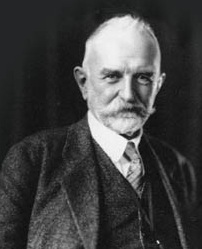
George Herbert Mead
George Herbert Mead (1863–1931) was an American philosopher, sociologist, and psychologist, primarily affiliated with the University of Chicago, where he was one of several distinguished pragmatists. He is regarded as one of the founders of social psychology and the American sociological tradition in general.
This process is characterized by Mead as the “I” and the “me. ” The “me” is the social self and the “I” is the response to the “me. ” In other words, the “I” is the response of an individual to the attitudes of others, while the “me” is the organized set of attitudes of others which an individual assumes. The “me” is the accumulated understanding of the “generalized other,” i.e. how one thinks one’s group perceives oneself. The “I” is the individual’s impulses. The “I” is self as subject; the “me” is self as object. The “I” is the knower, the “me” is the known. The mind, or stream of thought, is the self-reflective movements of the interaction between the “I” and the “me. ” These dynamics go beyond selfhood in a narrow sense, and form the basis of a theory of human cognition. For Mead the thinking process is the internalized dialogue between the “I” and the “me. “
Understood as a combination of the “I” and the “me,” Mead’s self proves to be noticeably entwined within a sociological existence. For Mead, existence in a community comes before individual consciousness. First one must participate in the different social positions within society and only subsequently can one use that experience to take the perspective of others and become self-conscious.
4.2.3: Psychological Approaches to the Self
The psychology of self is the study of either the cognitive or affective representation of one’s identity.
Learning Objective
Discuss the development of a person’s identity in relation to both the Kohut and Jungian self
Key Points
- The earliest formulation of the self in modern psychology derived from the distinction between the self as I, the subjective knower, and the self as Me, the object that is known.
- Heinz Kohut, an American psychologist, theorized that the self was bipolar, and was comprised of two systems of narcissistic perfection, one of which contained ambitions and the other of which contained ideals.
- In Jungian theory, derived from the psychologist C.G. Jung, the Self is one of several archetypes. It signifies the coherent whole, unifying both the consciousness and unconscious mind of a person.
- Social constructivists claim that timely and sensitive intervention by adults when a child is on the edge of learning a new task could help children learn new tasks.
- Attachment theory focuses on open, intimate, emotionally meaningful relationships.
- The nativism versus empiricism debate focuses on the relationship between innateness and environmental influence in regard to any particular aspect of development.
- A nativist account of development would argue that the processes in question are innate, that is, they are specified by the organism’s genes. An empiricist perspective would argue that those processes are acquired in interaction with the environment.
Key Terms
- archetype
-
according to the Swiss psychologist Carl Jung, a universal pattern of thought, present in an individual’s unconscious, inherited from the past collective experience of humanity
- affective
-
relating to, resulting from, or influenced by the emotions
- cognitive
-
the part of mental functions that deals with logic, as opposed to affective functions which deal with emotions
Example
- One can see how developmental psychology has become de rigeur in changes in parenting tactics. Since the publication of these studies, parents and caregivers pay even more attention to affection and encouraging hands on play. Encouraging a child to complete an art project and hugging her upon its completion is an example of how these theories are implemented in everyday life.
Psychology of the Self
The psychology of the self is the study of the cognitive or affective representation of one’s identity. In modern psychology, the earliest formulation of the self derived from the distinction between the self as “I,” the subjective knower, and the self as “me,” the object that is known. Put differently, let us say an individual wanted to think about their “self” as an analytic object. They might ask themselves the question, “what kind of person am I? ” That person is still, in that moment, thinking from some perspective, which is also considered the “self. ” Thus, in this case, the “self” is both what is doing the thinking, and also, at the same time, the object that is being thought about. It is from this dualism that the concept of the self initially emerged in modern psychology. Current psychological thought suggests that the self plays an integral part in human motivation, cognition, affect, and social identity.
The Kohut Self
Heinz Kohut, an American psychologist, theorized a bipolar self that was comprised of two systems of narcissistic perfection, one of which contained ambitions and the other of which contained ideals. Kohut called the pole of ambitions the narcissistic self (later called the grandiose self). He called the pole of ideals the idealized parental imago. According to Kohut, the two poles of the self represented natural progressions in the psychic life of infants and toddlers.
The Jungian Self
In Jungian theory, derived from the psychologist C.G. Jung , the Self is one of several archetypes. It signifies the coherent whole, unifying both the conscious and unconscious mind of a person. The Self, according to Jung, is the end product of individuation, which is defined as the process of integrating one’s personality. For Jung, the Self could be symbolized by either the circle (especially when divided into four quadrants), the square, or the mandala. He also believed that the Self could be symbolically personified in the archetypes of the Wise Old Woman and Wise Old Man.

Carl Gustav Jung
According to Jung, the Self is one of several archetypes.
In contrast to earlier theorists, Jung believed that an individual’s personality had a center. While he considered the ego to be the center of an individual’s conscious identity, he considered the Self to be the center of an individual’s total personality. This total personality included within it the ego, consciousness, and the unconscious mind. To Jung, the Self is both the whole and the center. While Jung perceived the ego to be a self-contained, off-centered, smaller circle contained within the whole, he believed that the Self was the greater circle. In addition to being the center of the psyche, Jung also believed the Self was autonomous, meaning that it exists outside of time and space. He also believed that the Self was the source of dreams, and that the Self would appear in dreams as an authority figure that could either perceive the future or guide an individual’s present.
4.3: Theories of Socialization
4.3.1: Theories of Socialization
Socialization is the means by which human infants begin to acquire the skills necessary to perform as functioning members of their society.
Learning Objective
Discuss the different types and theories of socialization
Key Points
- Group socialization is the theory that an individual’s peer groups, rather than parental figures, influences his or her personality and behavior in adulthood.
- Gender socialization refers to the learning of behavior and attitudes considered appropriate for a given sex.
- Cultural socialization refers to parenting practices that teach children about their racial history or heritage and, sometimes, is referred to as pride development.
- Sigmund Freud proposed that the human psyche could be divided into three parts: Id, ego, and super-ego.
- Piaget’s theory of cognitive development is a comprehensive theory about the nature and development of human intelligence.
- Positive Adult Development is one of the four major forms of adult developmental study that can be identified. The other three forms are directionless change, stasis, and decline.
Key Term
- socialization
-
The process of learning one’s culture and how to live within it.
Example
- Primary Socialization occurs when a child learns the attitudes, values, and actions appropriate to individuals as members of a particular culture. For example if a child saw his/her mother expressing a discriminatory opinion about a minority group, then that child may think this behavior is acceptable and could continue to have this opinion about minority groups.
“Socialization” is a term used by sociologists, social psychologists, anthropologists, political scientists, and educationalists to refer to the lifelong process of inheriting and disseminating norms, customs, and ideologies, providing an individual with the skills and habits necessary for participating within his or her own society. Socialization is thus “the means by which social and cultural continuity are attained.”
Socialization is the means by which human infants begin to acquire the skills necessary to perform as a functioning member of their society and is the most influential learning process one can experience. Unlike other living species, whose behavior is biologically set, humans need social experiences to learn their culture and to survive. Although cultural variability manifests in the actions, customs, and behaviors of whole social groups, the most fundamental expression of culture is found at the individual level. This expression can only occur after an individual has been socialized by his or her parents, family, extended family, and extended social networks.
The looking-glass self is a social psychological concept, created by Charles Horton Cooley in 1902, stating that a person’s self grows out of society’s interpersonal interactions and the perceptions of others. The term refers to people shaping themselves based on other people’s perception, which leads people to reinforce other people’s perspectives on themselves. People shape themselves based on what other people perceive and confirm other people’s opinion on themselves.
George Herbert Mead developed a theory of social behaviorism to explain how social experience develops an individual’s personality. Mead’s central concept is the self: the part of an individual’s personality composed of self-awareness and self-image. Mead claimed that the self is not there at birth, rather, it is developed with social experience.
Sigmund Freud was an Austrian neurologist who founded the discipline of psychoanalysis, a clinical method for treating psychopathology through dialogue between a patient and a psychoanalyst. In his later work, Freud proposed that the human psyche could be divided into three parts: Id, ego, and super-ego. The id is the completely unconscious, impulsive, child-like portion of the psyche that operates on the “pleasure principle” and is the source of basic impulses and drives; it seeks immediate pleasure and gratification. The ego acts according to the reality principle (i.e., it seeks to please the id’s drive in realistic ways that will benefit in the long term rather than bringing grief). Finally, the super-ego aims for perfection. It comprises that organized part of the personality structure, mainly but not entirely unconscious that includes the individual’s ego ideals, spiritual goals, and the psychic agency that criticizes and prohibits his or her drives, fantasies, feelings, and actions.
Different Forms of Socialization
Group socialization is the theory that an individual’s peer groups, rather than parental figures, influences his or her personality and behavior in adulthood. Adolescents spend more time with peers than with parents. Therefore, peer groups have stronger correlations with personality development than parental figures do. For example, twin brothers, whose genetic makeup are identical, will differ in personality because they have different groups of friends, not necessarily because their parents raised them differently.
Gender socialization Henslin (1999) contends that “an important part of socialization is the learning of culturally defined gender roles” (p. 76). Gender socialization refers to the learning of behavior and attitudes considered appropriate for a given sex. Boys learn to be boys, and girls learn to be girls. This “learning” happens by way of many different agents of socialization. The family is certainly important in reinforcing gender roles, but so are one’s friends, school, work, and the mass media. Gender roles are reinforced through “countless subtle and not so subtle ways,” said Henslin (1999, p. 76).
Cultural socialization refers to parenting practices that teach children about their racial history or heritage and, sometimes, is referred to as “pride development. ” Preparation for bias refers to parenting practices focused on preparing children to be aware of, and cope with, discrimination. Promotion of mistrust refers to the parenting practices of socializing children to be wary of people from other races. Egalitarianism refers to socializing children with the belief that all people are equal and should be treated with a common humanity.
4.3.2: Cooley
In 1902, Charles Horton Cooley created the concept of the looking-glass self, which explored how identity is formed.
Learning Objective
Discuss Cooley’s idea of the “looking-glass self” and how people use socialization to create a personal identity and develop empathy for others
Key Points
- The looking-glass self is a social psychological concept stating that a person’s self grows out of society’s interpersonal interactions and the perceptions of others.
- There are three components of the looking-glass self: We imagine how we appear to others, we imagine the judgment of that appearance, and we develop our self (identity) through the judgments of others.
- George Herbert Mead described self as “taking the role of the other,” the premise for which the self is actualized. Through interaction with others, we begin to develop an identity about who we are, as well as empathy for others.
Key Terms
- George Herbert Mead
-
(1863–1931) An American philosopher, sociologist, and psychologist, primarily affiliated with the University of Chicago, where he was one of several distinguished pragmatists.
- Looking-Glass self
-
The looking-glass self is a social psychological concept, created by Charles Horton Cooley in 1902, stating that a person’s self grows out of society’s interpersonal interactions and the perceptions of others.
- Charles Horton Cooley
-
Charles Horton Cooley (August 17, 1864-May 8, 1929) was an American sociologist and the son of Thomas M. Cooley. He studied and went on to teach economics and sociology at the University of Michigan, and he was a founding member and the eighth president of the American Sociological Association.
Example
- An example of the looking-self concept is computer technology. Using computer technology, people can create an avatar, a customized symbol that represents the computer user. For example, in the virtual world Second Life the computer-user can create a humanlike avatar that reflects the user in regard to race, age, physical makeup, status and the like. By selecting certain physical characteristics or symbols, the avatar reflects how the creator seeks to be perceived in the virtual world and how the symbols used in the creation of the avatar influence others’ actions toward the computer-user.
The looking-glass self is a social psychological concept created by Charles Horton Cooley in 1902. It states that a person’s self grows out of society’s interpersonal interactions and the perceptions of others. The term refers to people shaping their identity based on the perception of others, which leads the people to reinforce other people’s perspectives on themselves. People shape themselves based on what other people perceive and confirm other people’s opinion of themselves.
There are three main components of the looking-glass self:
- First, we imagine how we must appear to others.
- Second, we imagine the judgment of that appearance.
- Finally, we develop our self through the judgments of others.
In hypothesizing the framework for the looking glass self, Cooley said, “the mind is mental” because “the human mind is social. ” In other words, the mind’s mental ability is a direct result of human social interaction. Beginning as children, humans begin to define themselves within the context of their socializations. The child learns that the symbol of his/her crying will elicit a response from his/her parents, not only when they are in need of necessities, such as food, but also as a symbol to receive their attention. George Herbert Mead described the self as “taking the role of the other,” the premise for which the self is actualized. Through interaction with others, we begin to develop an identity about who we are, as well as empathy for others.
An example of the looking-self concept is computer technology. Using computer technology, people can create an avatar, a customized symbol that represents the computer user. For example, in the virtual world Second Life, the computer-user can create a human-like avatar that reflects the user in regard to race, age, physical makeup, status, and the like. By selecting certain physical characteristics or symbols, the avatar reflects how the creator seeks to be perceived in the virtual world and how the symbols used in the creation of the avatar influence others’ actions toward the computer user.
4.3.3: Mead
For Mead, the self arises out of the social act of communication, which is the basis for socialization.
Learning Objective
Discuss Mead’s theory of social psychology in terms of two concepts – pragmatism and social behaviorism
Key Points
- George Herbert Mead was an American philosopher, sociologist, and psychologist and one of several distinguished pragmatists.
- The two most important roots of Mead’s work are the philosophy of pragmatism and social behaviorism.
- Pragmatism is a wide-ranging philosophical position that states that people define the social and physical “objects” they encounter in the world according to their use for them.
- One of his most influential ideas was the emergence of mind and self from the communication process between organisms, discussed in the book, Mind, Self and Society, also known as social behaviorism.
Key Terms
- symbolic interactionism
-
Symbolic interactionism is the study of the patterns of communication, interpretation, and adjustment between individuals.
- social behaviorism
-
Discussed in the book, Mind, Self and Society, social behaviorism refers to the emergence of mind and self from the communication process between organisms.
- pragmatism
-
The theory that problems should be met with practical solutions rather than ideological ones; a concentration on facts rather than emotions or ideals.
Example
- In Pragmatism, nothing practical or useful is held to be necessarily true, nor is anything which helps to survive merely in the short term. For example, to believe my cheating spouse is faithful may help me feel better now, but it is certainly not useful from a more long-term perspective because it doesn’t accord with the facts (and is therefore not true).
George Herbert Mead was an American philosopher, sociologist, and psychologist, primarily affiliated with the University of Chicago, where he was one of several distinguished pragmatists. He is regarded as one of the founders of social psychology and the American sociological tradition in general.
The two most important roots of Mead’s work, and of symbolic interactionism in general, are the philosophy of pragmatism and social behaviorism. Pragmatism is a wide ranging philosophical position from which several aspects of Mead’s influences can be identified. There are four main tenets of pragmatism: First, to pragmatists true reality does not exist “out there” in the real world, it “is actively created as we act in and toward the world. Second, people remember and base their knowledge of the world on what has been useful to them and are likely to alter what no longer “works. ” Third, people define the social and physical “objects” they encounter in the world according to their use for them. Lastly, if we want to understand actors, we must base that understanding on what people actually do. In Pragmatism nothing practical or useful is held to be necessarily true, nor is anything which helps to survive merely in the short term. For example, to believe my cheating spouse is faithful may help me feel better now, but it is certainly not useful from a more long-term perspective because it doesn’t align with the facts (and is therefore not true).
Mead was a very important figure in twentieth century social philosophy. One of his most influential ideas was the emergence of mind and self from the communication process between organisms, discussed in the book, Mind, Self and Society, also known as social behaviorism. For Mead, mind arises out of the social act of communication. Mead’s concept of the social act is relevant, not only to his theory of mind, but also to all facets of his social philosophy. His theory of “mind, self, and society” is, in effect, a philosophy of the act from the standpoint of a social process involving the interaction of many individuals, just as his theory of knowledge and value is a philosophy of the act from the standpoint of the experiencing individual in interaction with an environment.
Mead is a major American philosopher by virtue of being, along with John Dewey, Charles Peirce, and William James, one of the founders of pragmatism. He also made significant contributions to the philosophies of nature, science, and history, to philosophical anthropology, and to process philosophy. Dewey and Alfred North Whitehead considered Mead a thinker of the first rank. He is a classic example of a social theorist whose work does not fit easily within conventional disciplinary boundaries.
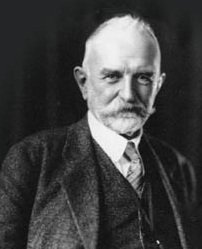
George Herbert Mead
George Herbert Mead (1863–1931) was an American philosopher, sociologist, and psychologist, primarily affiliated with the University of Chicago, where he was one of several distinguished pragmatists. He is regarded as one of the founders of social psychology and the American sociological tradition in general.
4.3.4: Freud
According to Freud, human behavior, experience, and cognition are largely determined by unconscious drives and events in early childhood.
Learning Objective
Discuss Freud’s “id”, “ego” and “super-ego” and his six basic principles of psychoanalysis and how psychoanalysis is used today as a treatment for a variety of psychological disorders
Key Points
- Psychoanalysis is a clinical method for treating psychopathology through dialogue between a patient and a psychoanalyst.
- The specifics of the analyst’s interventions typically include confronting and clarifying the patient’s pathological defenses, wishes, and guilt.
- Freud named his new theory the Oedipus complex after the famous Greek tragedy Oedipus Rex by Sophocles. The Oedipus conflict was described as a state of psychosexual development and awareness.
- The id is the completely unconscious, impulsive, child-like portion of the psyche that operates on the “pleasure principle” and is the source of basic impulses and drives.
- The ego acts according to the reality principle (i.e., it seeks to please the id’s drive in realistic ways that will benefit in the long term rather than bringing grief).
- The super-ego aims for perfection. It comprises that organized part of the personality structure.
- The super-ego aims for perfection. It comprises that organised part of the personality structure
Key Terms
- Oedipus complex
-
In Freudian theory, the complex of emotions aroused in a child by an unconscious sexual desire for the parent of the opposite sex.
- the unconscious
-
For Freud, the unconscious refers to the mental processes of which individuals make themselves unaware.
Example
- The most common problems treatable with psychoanalysis include: phobias, conversions, compulsions, obsessions, anxiety, attacks, depressions, sexual dysfunctions, a wide variety of relationship problems (such as dating and marital strife), and a wide variety of character problems (painful shyness, meanness, obnoxiousness, workaholism, hyperseductiveness, hyperemotionality, hyperfastidiousness).
Sigmund Freud was an Austrian neurologist who founded the discipline of psychoanalysis. Interested in philosophy as a student, Freud later decided to become a neurological researcher in cerebral palsy, Aphasia, and microscopic neuroanatomy. Freud went on to develop theories about the unconscious mind and the mechanism of repression and established the field of verbal psychotherapy by creating psychoanalysis, a clinical method for treating psychopathology through dialogue between a patient and a psychoanalyst. The most common problems treatable with psychoanalysis include phobias, conversions, compulsions, obsessions, anxiety, attacks, depressions, sexual dysfunctions, a wide variety of relationship problems (such as dating and marital strife), and a wide variety of character problems (painful shyness, meanness, obnoxiousness, workaholism, hyperseductiveness, hyperemotionality, hyperfastidiousness).
The Basic Tenets of Psychoanalysis
The basic tenets of psychoanalysis include the following:
- First, human behavior, experience, and cognition are largely determined by irrational drives.
- Those drives are largely unconscious.
- Attempts to bring those drives into awareness meet psychological resistance in the form of defense mechanisms.
- Besides the inherited constitution of personality, one’s development is determined by events in early childhood.
- Conflicts between conscious view of reality and unconscious (repressed) material can result in mental disturbances, such as neurosis, neurotic traits, anxiety, depression etc.
- The liberation from the effects of the unconscious material is achieved through bringing this material into the consciousness.
Psychoanalysis as Treatment
Freudian psychoanalysis refers to a specific type of treatment in which the “analysand” (the analytic patient) verbalizes thoughts, including free associations, fantasies, and dreams, from which the analyst induces the unconscious conflicts. This causes the patient’s symptoms and character problems, and interprets them for the patient to create insight for resolution of the problems. The specifics of the analyst’s interventions typically include confronting and clarifying the patient’s pathological defenses, wishes, and guilt. Through the analysis of conflicts, including those contributing to resistance and those involving transference onto the analyst of distorted reactions, psychoanalytic treatment can hypothesize how patients unconsciously are their own worst enemies: how unconscious, symbolic reactions that have been stimulated by experience are causing symptoms.
The Id, The Ego, Super-Ego
Freud hoped to prove that his model was universally valid and thus turned to ancient mythology and contemporary ethnography for comparative material. Freud named his new theory the Oedipus complex after the famous Greek tragedy Oedipus Rex by Sophocles. The Oedipus conflict was described as a state of psychosexual development and awareness. In his later work, Freud proposed that the human psyche could be divided into three parts: Id, ego, and super-ego. The id is the completely unconscious, impulsive, child-like portion of the psyche that operates on the “pleasure principle” and is the source of basic impulses and drives; it seeks immediate pleasure and gratification. The ego acts according to the reality principle (i.e., it seeks to please the id’s drive in realistic ways that will benefit in the long term rather than bringing grief). Finally, the super-ego aims for perfection. It comprises that organized part of the personality structure, mainly but not entirely unconscious, that includes the individual’s ego, ideals, spiritual goals, and the psychic agency that criticizes and prohibits his or her drives, fantasies, feelings, and actions.
4.3.5: Piaget
Piaget’s theory of cognitive development is a comprehensive theory about the nature and development of human intelligence.
Learning Objective
Analyze the differences between accommodation and assimilation, in relation to Piaget’s stages
Key Points
- Jean Piaget was a French-speaking Swiss developmental psychologist and philosopher known for his epistemological studies with children. His theory of cognitive development and epistemological view are together called “genetic epistemology,” the study of the origins of knowledge.
- Piaget argued that all people undergo a series of stages and transformations. Transformations refer to all manners of changes that a thing or person can experience, while states refer to the conditions or the appearances in which things or persons can be found between transformations.
- Piaget identified four stages of cognitive development: sensorimotor, pre-operational, concrete operational, and formal operational. Through these stages, children progress in their thinking and logical processes.
- Piaget’s theory of cognitive development is a comprehensive theory about the nature and development of human intelligence that explains how individuals perceive and adapt to new information through the processes of assimilation and accommodation.
- Assimilation is the process of taking one’s environment and new information and fitting it into pre-existing cognitive schemas. Accommodation is the process of taking one’s environment and new information, and altering one’s pre-existing schemas in order to fit in the new information.
- Object permanence is the understanding that objects continue to exist even when they cannot be seen, heard, or touched.
- Object permanence is the understanding that objects continue to exist even when they cannot be seen, heard, or touched.
- The concrete operational stage is the third of four stages of cognitive development in Piaget’s theory.
- The final stage is known as formal operational stage (adolescence and into adulthood): Intelligence is demonstrated through the logical use of symbols related to abstract concepts.
Key Terms
- accommodation
-
Accommodation, unlike assimilation, is the process of taking one’s environment and new information, and altering one’s pre-existing schemas in order to fit in the new information.
- object permanence
-
The understanding (typically developed during early infancy) that an object still exists even when it disappears from sight, or other senses.
- genetic epistemology
-
Genetic epistemology is a study of the origins of knowledge. The discipline was established by Jean Piaget.
Jean Piaget was a French-speaking Swiss developmental psychologist and philosopher known for his epistemological studies with children. His theory of cognitive development and epistemological view are together called “genetic epistemology. ” He believed answers for the epistemological questions at his time could be better addressed by looking at their genetic components. This led to his experiments with children and adolescents in which he explored the thinking and logic processes used by children of different ages.
Piaget’s theory of cognitive development is a comprehensive theory about the nature and development of human intelligence. Piaget believed that reality is a dynamic system of continuous change and as such, it is defined in reference to the two conditions that define dynamic systems. Specifically, he argued that reality involves transformations and states. Transformations refer to all manners of changes that a thing or person can undergo. States refer to the conditions or the appearances in which things or persons can be found between transformations.
Piaget explains the growth of characteristics and types of thinking as the result of four stages of development. The stages are as follows:
- The sensorimotor stage is the first of the four stages in cognitive development that “extends from birth to the acquisition of language. ” In this stage, infants construct an understanding of the world by coordinating experiences with physical actions–in other words, infants gain knowledge of the word from the physical actions they perform. The development of object permanence is one of the most important accomplishments of this stage.
- The pre-operational stage is the second stage of cognitive development. It begins around the end of the second year. During this stage, the child learns to use and to represent objects by images, words, and drawings. The child is able to form stable concepts, as well as mental reasoning and magical beliefs.
- The third stage is called the “concrete operational stage” and occurs approximately between the ages of 7 and 11 years. In this stage, children develop the appropriate use of logic and are able to think abstractly, make rational judgments about concrete phenomena, and systematically manipulate symbols related to concrete objects.
- The final stage is known as the “formal operational stage” (adolescence and into adulthood). Intelligence is demonstrated through the logical use of symbols related to abstract concepts. At this point, the person is capable of hypothetical and deductive reasoning.
When studying the field of education Piaget identified two processes: accommodation and assimilation. Assimilation describes how humans perceive and adapt to new information. It is the process of taking one’s environment and new information and fitting it into pre-existing cognitive schemas. Accommodation, unlike assimilation, is the process of taking one’s environment and new information and altering one’s pre-existing schemas in order to fit in the new information.
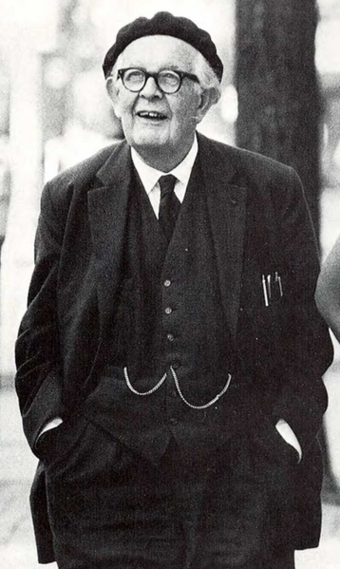
Jean Piaget
Jean Piaget was a French-speaking Swiss developmental psychologist and philosopher known for his epistemological studies with children.
4.3.6: Levinson
Daniel J. Levinson was one of the founders of the field of positive adult development.
Learning Objective
Summarize Daniel Levinson’s theory of positive adult development and how it influenced changes in the perception of development during adulthood
Key Points
- As a theory, positive adult development asserts that development continues after adolescence, long into adulthood.
- In positive adult development research, scientists question not only whether development ceases after adolescence, but also a notion, popularized by many gerontologists, that a decline occurs after late adolescence.
- Positive adult developmental processes are divided into at least six areas of study: hierarchical complexity, knowledge, experience, expertise, wisdom, and spirituality.
Key Terms
- positive adult development
-
Positive adult development is one of the four major forms of adult developmental study that can be identified.
- stasis
-
inactivity; a freezing, or state of motionlessness
- decline
-
downward movement, fall
Daniel Levinson
Daniel J. Levinson, an American psychologist, was one of the founders of the field of positive adult development. He was born in New York City on May 28, 1920, and completed his dissertation at the University of California, Berkeley, in 1947. In this dissertation, he attempted to develop a way of measuring ethnocentrism. In 1950, he moved to Harvard University. From 1966 to 1990, he was a professor of psychology at the Yale University School of Medicine.
Levinson’s two most important books were Seasons of a Man’s Life and Seasons of a Woman’s Life, which continue to be highly influential works. His multidisciplinary approach is reflected in his work on the life structure theory of adult development.
Positive Adult Development
Positive adult development is one of the four major forms of adult developmental study. The other three are directionless change, stasis, and decline. Positive adult developmental processes are divided into the following six areas of study:
- hierarchical complexity
- knowledge
- experience
- expertise
- wisdom
- spirituality
Research in this field questions not only whether development ceases after adolescence, but also the notion, popularized by many gerontologists, that a decline occurs after late adolescence. Research shows that positive development does still occur during adulthood. Recent studies indicate that such development is useful in predicting things such as an individual’s health, life satisfaction, and ability to contribute to society.
Now that there is scientific proof that individuals continue to develop as adults, researchers have begun investigating how to foster such development. Rather than just describing, as phenomenon, the fact that adults continue to develop, researchers are interested in aiding and guiding that development. For educators of adults in formal settings, this has been a priority in many ways already. More recently, researchers have begun to experiment with hypotheses about fostering positive adult development. These methods are used in organizational and educational setting. Some use developmentally-designed, structured public discourse to address complex public issues.
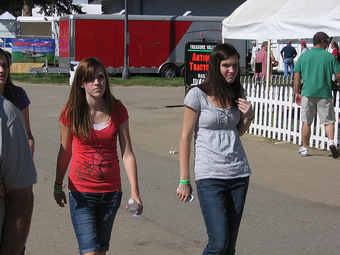
Positive Adult Development
Research in Positive Adult Development questions not only whether development ceases after adolescence, but also the notion, popularized by many gerontologists, that a decline occurs after late adolescence.
4.4: Learning Personality, Morality, and Emotions
4.4.1: Sociology of Emotion
The sociology of emotions applies sociological theorems and techniques to the study of human emotions.
Learning Objective
Examine the origins of the sociology of emotions through the work of Marx, Weber, and Simmel, and its development by T. David Kemper, Arlie Hochschild, Randall Collins, and David R. Heise
Key Points
- Emotions impact society on both the micro level (everyday social interactions) and the macro level (social institutions, discourses, and ideologies).
- Ethnomethodology revealed emotional commitments to everyday norms through purposeful breaching of the norms.
- We try to regulate our emotions to fit in with the norms of the situation, based on many, and sometimes conflicting demands upon us.
Key Terms
- ethnomethodology
-
An academic discipline that attempts to understand the social orders people use to make sense of the world through analyzing their accounts and descriptions of their day-to-day experiences.
- The sociology of emotions
-
The sociology of emotion applies sociological theorems and techniques to the study of human emotions.
Examples
- An example of individuals emotions’ impacting social interactions and institutions is how a Board of Directors will fail to be productive if the members are angry with one another.
- An example of the operations of a guilt society is how Americans expect a husband to feel guilty if he forgets his wife’s birthday. This expectation is the product of a guilt society.
- According to doctrine, many members of the Catholic church believe that people should feel shame for masturbating. This expectation is the product of a shame society.
The sociology of emotions applies sociological theorems and techniques to the study of human emotions. As sociology emerged, primarily as a reaction to the negative affects of modernity, many normative theories deal in some sense with “emotion” without forming a part of any specific subdiscipline: Marx described capitalism as detrimental to personal “species-being,” Simmel wrote of the deindividualizing tendencies of “the metropolis,” and Weber’s work dealt with the rationalizing effect of modernity in general.
Emotions operate on both micro and macro levels. On the micro level, social roles, norms, and feeling rules structure’s everyday social interactions. On a macro level, these same emotional processes structure social institutions, discourses, and ideologies. We try to regulate our emotions to fit in with the norms of the situation, based on many, and sometimes conflicting demands upon us. Systematic observations of group interaction found that a substantial portion of group activity is devoted to the socio-emotional issues of expressing affect and dealing with tension. Simultaneously, field studies of social attraction in groups revealed that feelings of individuals about each other collate into social networks, a discovery that still is being explored in the field of social network analysis.
Ethnomethodology revealed emotional commitments to everyday norms through purposeful breaching of the norms. In one study, a sociologist sent his students home and instructed them to act as guests rather than family members. Students reported others’ astonishment, bewilderment, shock, anxiety, embarrassment, and ange and family members accused the students of being mean, inconsiderate, selfish, nasty, or impolite.
Important theories and theoreticians relating to the sociology of emotion include:
- T. David Kemper: He proposed that people in social interaction have positions on two relational dimensions: status and power. Emotions emerge as interpersonal events, change or maintain individuals’ status and power.
- Arlie Hochschild: She proposed that individuals manage their feelings to produce acceptable displays according to ideological and cultural standards.
- Peggy Thoits: She divided emotion management techniques into implementation of new events and reinterpretation of past events. Thoits noted that emotions also can be managed with drugs, by performing faux gestures and facial expressions, or by cognitive reclassifications of one’s feelings.
- Thomas J. Scheff: He established that many cases of social conflict are based on a destructive and often escalating, but stoppable and reversible shame-rage cycle–when someone results or feels shamed by another, their social bond comes under stress.
- Randall Collins: He stated that emotional energy is the main motivating force in social life, for love and hatred, investing, working or consuming, and rendering cult or waging war.
- David R. Heise. He developed the Affect Control Theory, which proposes that social actions are designed by their agents to create impressions that befit sentiments reigning in a situation.
For more information on emotions, watch this video:
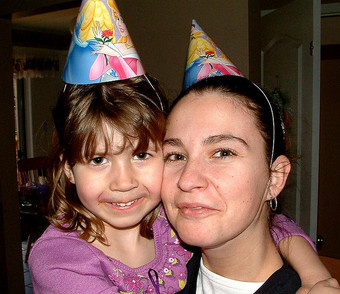
Social Significance of Emotion
The sociology of emotion suggests that individual emotional reactions, such as this girl’s happiness and excitement, impact social interactions and institutions.
4.4.2: Informal Social Control
Social control refers to societal processes that regulate individual and group behaviour in an attempt to gain conformity.
Learning Objective
Give examples of the difference between informal and formal means of social control
Key Points
- Informal control typically involves an individual internalizing certain norms and values. This process is known as socialization.
- Formal means of social control typically involve the state. External sanctions are enforced by the government to prevent chaos, violence, or anomie in society. Some theorists, such as Émile Durkheim, refer to this form of control as regulation.
- The social values present in individuals are products of informal social control, exercised implicitly by a society through particular customs, norms, and mores. Individuals internalize the values of their society, whether conscious or not of this indoctrination.
- Contemporary Western society uses shame as one modality of control, but its primary dependence rests on guilt, and, when that does not work, the criminal justice system.
Key Terms
- sanction
-
a penalty, or some coercive measure, intended to ensure compliance; especially one adopted by several nations, or by an international body
- conformity
-
the ideology of adhering to one standard or social uniformity
- compliance
-
the tendency of conforming with or agreeing to the wishes of others
Example
- An example of affect control theory in practice is how people behave at funerals. Even if someone didn’t know the person who passed away particularly well, the social situation encourages one to comport himself as if he were grieving.
Social Control
Social control refers to societal and political mechanisms that regulate individual and group behaviour in an attempt to gain conformity and compliance to the rules of a given society, state, or social group. Sociologists identify two basic forms of social control – informal control and formal control.
Formal Control
Formal social control typically involves the state. External sanctions are enforced by the government to prevent chaos, violence, or anomie in society. An example of this would be a law preventing individuals from committing theft. Some theorists, like Émile Durkheim, refer to this type of control as regulation.
Informal Control
Informal control typically involves an individual internalizing certain norms and values. This process is called socialization. The social values present in individuals are products of informal social control, exercised implicitly by a society through particular customs, norms, and mores. Individuals internalize the values of their society, whether conscious or not of this indoctrination.
Informal sanctions may include shame, ridicule, sarcasm, criticism, and disapproval, which can cause an individual to conform to the social norms of the society. In extreme cases, sanctions may include social discrimination, exclusion, and violence. Informal social control has the potential to have a greater impact on an individual than formal control. When social values become internalized, they become an aspect of an individual’s personality.
Informal sanctions check ‘deviant’ behavior. An example of a negative sanction is depicted in a scene in ‘The Wall,’ a film by Pink Floyd. In this scene, a young protagonist is ridiculed and verbally abused by a high school teacher for writing poetry in a mathematics class. Another example occurs in the movie ‘About a Boy. ” In this film, a young boy hesitates to jump from a high springboard and is ridiculed for his fear. Though he eventually jumps, his behaviour is controlled by shame, not by his internal desire to jump.

Informal means of control
At funerals, people tend to comport themselves to look as if they are grieving, even if they did not know the person who passed away. This is example of a social situation controlling an individual’s emotions.
4.5: Agents of Socialization
4.5.1: Family
A family serves to reproduce society biologically, through procreation, and socially, through the socialization of children.
Learning Objective
Analyze the pivotal role a family plays in the socialization of children and the continuation of society through procreation
Key Points
- Although a family can fulfill a variety of other functions, not all of these are universal or obligatory.
- The incest taboo, which prohibits sexual relations between family members, is a form of exogamy and may help promote social solidarity.
- The family of orientation refers to the role of the family in providing children with a position in society and socialize them.
- From the parents’ perspective, the family of procreation refers to the family’s role is to produce and socialize children.
- Exogamy is a social arrangement according to which marriages can only occur with members outside of one’s social group.
- Exogamy is a social arrangement according to which marriages can only occur with members outside of one’s social group.
Key Terms
- exogamy
-
Marriage to a person belonging to a tribe or group other than your own as required by custom or law.
- bridewealth
-
Bridewealth is the amount of money, wealth, or property paid by the family of the groom to the bride’s parents upon the marriage of the couple. The amount paid generally indicates the perceived value of the bride.
- family of procreation
-
the idea that the goal of a family is to produce and enculturate and socialize children
- family of orientation
-
This refers to the family in which an individual grows up.
The primary function of the family is to reproduce society, both biologically through procreation and socially through socialization. Given these functions, the individual’s experience of his or her family shifts over time. From the perspective of children, the family is a family of orientation: the family functions to locate children socially, and plays a major role in their socialization. From the point of view of the parent(s), the family is a family of procreation: The family functions to produce and socialize children. In some cultures, marriage imposes upon women the obligation to bear children. In northern Ghana, for example, payment of bridewealth, which is an amount of money, wealth, or property paid to the bride’s parents by the groom’s family, signifies a woman’s requirement to bear children, and women using birth control face substantial threats of physical abuse and reprisals.
Producing offspring is not the only function of the family. Marriage sometimes establishes the legal father of a woman’s child; establishes the legal mother of a man’s child; gives the husband or his family control over the wife’s sexual services, labor, and/or property; gives the wife or her family control over the husband’s sexual services, labor, and/or property; establishes a joint fund of property for the benefit of children; establishes a relationship between the families of the husband and wife. None of these functions are universal, nor are all of them inherent to any one society. In societies with a sexual division of labor, marriage, and the resulting relationship between a husband and wife, is necessary for the formation of an economically productive household. In modern societies, marriage entails particular rights and privileges which encourage the formation of new families even when there is no intention of having children.
In most societies, marriage between brothers and sisters is forbidden. In many societies, marriage between some first cousins is preferred, while at the other extreme, the medieval Catholic Church prohibited marriage even between distant cousins. The present day Catholic Church still maintains a standard of required distance for marriage.
These sorts of restrictions can be classified as an incest taboo, which is a cultural norm or rule that forbids sexual relations between family members and relatives. Incest taboo may serve to promote social solidarity and is a form of exogamy. Exogamy can be broadly defined as a social arrangement according to which marriages can only occur with members outside of one’s social group. One exception to this pattern is in ancient Egypt, where marriage between brothers and sisters was permitted in the royal family, as it was also the case in Hawaii and among the Inca. This privilege was denied commoners and may have served to concentrate wealth and power in one family.

Family
Families have strong ties and, therefore, are powerful agents of socialization.
4.5.2: Neighborhood
A neighborhood is a geographically localized community within a larger city, town, or suburb.
Learning Objective
Justify the importance of neighborhoods and communities as units of socialization, especially when specialized, such as by ethnicity or religion
Key Points
- Ethnic neighborhoods were important in many historical cities, and they remain common in modern cities.
- Rural-to-urban migration contributed to neighborhood distinctiveness and social cohesion in historical cities.
- A community is a group of interacting people, living in some proximity. Community usually refers to a social unit—larger than a household—that shares common values and has social cohesion.
- Social capital refers to a sense of connectedness due to the formation of social networks in a given community.
Key Terms
- community
-
A group sharing a common understanding and often the same language, manners, tradition and law. See civilization.
- ethnic enclave
-
An ethnic enclave is an ethnic community which retains some cultural distinction from a larger, surrounding area, it may be a neighborhood, an area or an administrative division based on ethnic groups.
- social capital
-
The good will, sympathy, and connections created by social interaction within and between social networks.
Example
- Chinatown is an example of an ethnic neighborhood.
A neighborhood is a geographically localized community within a larger city, town, or suburb. Neighborhoods are often social communities with considerable face-to-face interaction among members. Neighborhoods are typically generated by social interaction among people living near one another. In this sense, they are local social units larger than households, but not directly under the control of city or state officials. In some preindustrial urban traditions, basic municipal functions such as protection, social regulation of births and marriages, cleaning, and upkeep are handled informally by neighborhoods and not by urban governments; this pattern is well documented for historical Islamic cities. In addition to social neighbourhoods, most ancient and historical cities also had administrative districts used by officials for taxation, record-keeping, and social control.
Specialization and Differentiation
Neighborhoods in preindustrial cities often had some degree of social specialization or differentiation. Ethnic enclaves were important in many past cities and remain common in cities today. Economic specialists, including craft producers, merchants, and others could be concentrated in neighborhoods. Other neighborhoods were united by religious persuasion. One factor contributing to neighborhood distinctiveness and social cohesion was the role of rural to urban migration. This was a continual process for preindustrial cities in which migrants tended to move in with relatives and acquaintances from their rural past.
On another level, a community is a group of interacting people, living in some proximity. Community usually refers to a social unit—larger than a household—that shares common values and has social cohesion. The sense of community and formation of social networks comprise what has become known as social capital.

Chelsea
This image is of Chelsea neighborhood of Manhattan in New York City.
4.5.3: School
Education is the process by which society transmits its accumulated knowledge, skills, customs and values from one generation to another.
Learning Objective
Explain the role of both formal and informal education in the socialization process, such as learning norms and expectations, as well as gaining social equality
Key Points
- The sociology of education is the study of how public institutions and individual experiences affect education and its outcomes.
- A systematic sociology of education began with Émile Durkheim’s work on moral education as a basis for organic solidarity.
- Socialization is the process by which the new generation learns the knowledge, attitudes and values that they will need as productive citizens.
- The hidden curriculum is a subtler, but nonetheless powerful, indoctrination of the norms and values of the wider society.
Key Terms
- hidden curriculum
-
A curriculum that goes beyond the explicit demands of the formal curriculum. The goals and requirements of the hidden curriculum are unstated, but inflexible. They concern not what students learn but how and when they learn.
- the sociology of education
-
The sociology of education is the study of how public institutions and individual experiences affect education and its outcomes.
- socialization
-
The process of learning one’s culture and how to live within it.
Example
- When teaching kindergarten, a teacher may assign students to practice addition with one another. This lesson both educates children in basic mathematics and in the social values of teamwork and reciprocity. In this example, teamwork and reciprocity are examples of the “hidden curriculum. “
Education is the means through which the aims and habits of a group of people is transmitted from one generation to the next. Generally, it occurs through any experience that has a formative effect on the way one thinks, feels, or acts. In its narrow, technical sense, education is the formal process by which society deliberately transmits its accumulated knowledge, skills, customs and values from one generation to another. The sociology of education is the study of how public institutions and individual experiences affect education and its outcomes. It is most concerned with the public schooling systems of modern industrial societies, including the expansion of higher, adult, and continuing education.
Education has often been seen as a fundamentally optimistic human endeavor characterized by aspirations for progress and betterment. It is understood by many to be a means of overcoming limitations, achieving greater equality and acquiring wealth and social status. Education is perceived as an endeavor that enables children to develop according to their unique needs and potential. It is also perceived as one of the best means of achieving greater social equality. Some take a particularly negative view, arguing that the education system is intentionally designed to perpetuate the social reproduction of inequality.
A systematic sociology of education began with Émile Durkheim’s work on moral education as a basis for organic solidarity. It was after World War II, however, that the subject received renewed interest around the world: from technological functionalism in the US, egalitarian reform of opportunity in Europe, and human-capital theory in economics. These all implied that, with industrialization, the need for a technologically-skilled labor force undermines class distinctions and other ascriptive systems of stratification, and that education promotes social mobility.
Structural functionalists believe that society leans towards social equilibrium and social order. Socialization is the process by which the new generation learns the knowledge, attitudes and values that they will need as productive citizens. Although this aim is stated in the formal curriculum, it is mainly achieved through “the hidden curriculum”, a subtler, but nonetheless powerful, indoctrination of the norms and values of the wider society. Students learn these values because their behavior at school is regulated until they gradually internalize and accept them. For example, most high school graduates are socialized to either enter college or the workforce after graduation. This is an expectation set forth at the beginning of a student’s education.
Education also performs another crucial function. As various jobs become vacant, they must be filled with the appropriate people. Therefore, the other purpose of education is to sort and rank individuals for placement in the labor market. Those with high achievement will be trained for the most skilled and intellectually tasking jobs and in reward, be given the highest income. On the other hand, those who achieve the least, will be given the least demanding jobs, and hence the least income.

School
School serves as a primary site of education, including the inculcation of “hidden curricula” of social values and norms.
4.5.4: Day Care
Day care, in which children are cared for by a person other than their legal guardians, contributes to their socialization.
Learning Objective
Discuss how the use of day care (ranging from relative care to preschools) impacts the socialization of children in both a positive and negative way
Key Points
- Studies have shown that while bad day care can result in physical and emotional problems, good day care is not harmful to noninfants and may even lead to better outcomes.
- The day care industry is a continuum from personal parental care to large, regulated institutions.
- Early childhood education is the formal education and care of young children by people other than their family in settings outside of their homes and before the age of normal schooling.
Key Term
- early childhood education
-
The formal teaching and care of young children by people other than their family in settings outside of the home and before the age of normal schooling.
Example
- Examples of day care range from the next door neighbor watching one’s children to hiring a babysitter to large day care facilities that resemble preschools.
Day care is the care of a child during the day by a person other than the child’s legal guardians, typically performed by someone outside the child’s immediate family. Day care is typically a service during specific periods, such as when parents are at work . Child care is provided in nurseries or crèches, or by a nanny or family child care provider caring for children in their own homes. It can also take on a more formal structure, with education, child development, discipline, and even preschool education falling into the fold of services.
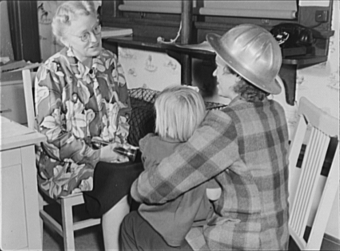
Day Care
A mother who works in construction drops her child off at daycare prior to work.
The day care industry is a continuum from personal parental care to large, regulated institutions. The vast majority of childcare is still performed by the parents, in house nanny, or through informal arrangements with relatives, neighbors, or friends. Another factor favoring large corporate day cares is the existence of childcare facilities in the workplace. Large corporations will not handle this employee benefit directly themselves and will seek out large corporate providers to manage their corporate daycares. Most smaller, for-profit day cares operate out of a single location.
Independent studies suggest that good day care for non-infants is not harmful. Some advocate that day care is inherently inferior to parental care. In some cases, good daycare can provide different experiences than parental care does, especially when children reach two and are ready to interact with other children. Bad day care puts the child at physical, emotional, and attachment risk. Higher quality care is associated with better outcomes. Children in higher quality child care had somewhat better language and cognitive development during the first 4½ years of life than those in lower quality care. They were also somewhat more cooperative than those who experienced lower quality care during the first three years of life.
As a matter of social policy, consistent, good daycare may ensure adequate early childhood education for children of less skilled parents. From a parental perspective, good daycare can complement good parenting. Early childhood education is the formal teaching and care of young children by people other than their family in settings outside of the home. “Early childhood” is usually defined as before the age of normal schooling – five years in most nations, though the U.S. National Association for the Education of Young Children (NAEYC) instead defines “early childhood” as before the age of eight.
4.5.5: Peer Groups
A peer group, whose members have interests, social positions, and age in common, have an influence on the socialization of group members.
Learning Objective
Analyze the importance of the peer group in terms of childhood and adolescent socialization
Key Points
- This is where children can escape supervision and learn to form relationships on their own.
- The influence of the peer group typically peaks during adolescence.
- However, peer groups generally only affect short term interests unlike the family, which has long term influence.
- Peer groups can also serve as a venue for teaching members gender roles.
- Adolescent peer groups provide support for children and teens as they assimilate into the adult society decreasing dependence on parents, increasing feeling of self-sufficiency, and connecting with a much larger social network.
- The term “peer pressure” is often used to describe instances where an individual feels indirectly pressured into changing their behavior to match that of their peers.
Key Terms
- Peer group
-
A peer group is a social group whose members have interests, social positions, and age in common.
- gender roles
-
Sets of social and behavioral norms that are generally considered appropriate for either a man or a woman in a social or interpersonal relationship.
- peer pressure
-
Peer pressure is the influence exerted by a peer group, encouraging individuals to change their attitudes, values, or behaviors in order to conform to group norms.
Example
- Teenagers encouraging their friends to smoke, drink, or engage in other risky behavior is an example of peer pressure. Peer pressure can also work in positive ways by encouraging teenagers to practice, study, or engage in other positive behaviors.
A peer group is a social group whose members have interests, social positions, and age in common. This is where children can escape supervision and learn to form relationships on their own. The influence of the peer group typically peaks during adolescence. However, peer groups generally only affect short term interests unlike the family, which has long term influence.
Unlike the family and the school, the peer group lets children escape the direct supervision of adults. Among peers, children learn to form relationships on their own. Peer groups also offer the chance to discuss interests that adults may not share with their children (such as clothing and popular music) or permit (such as drugs and sex).
Peer groups have a significant influence on psychological and social adjustments for group individuals. They provide perspective outside of individual’s viewpoints. Members inside peer groups also learn to develop relationships with others in the social system. Peers, particularly group members, become important social referents for teaching members’ customs, social norms, and different ideologies.
Peer groups can also serve as a venue for teaching members gender roles. Through gender-role socialization group members learn about sex differences, social and cultural expectations. While boys and girls differ greatly there is not a one to one link between sex and gender role with males always being masculine and female always being feminine. Both genders can contain different levels of masculinity and femininity.
Adolescent peer groups provide support for children and teens as they assimilate into the adult society decreasing dependence on parents, increasing feeling of self-sufficiency, and connecting with a much larger social network. Peer groups cohesion is determined and maintained by such factors as group communication, group consensus, and group conformity concerning attitude and behavior. As members of peer groups interconnect, and agree, a normative code arises. This normative code can become very rigid deciding group behavior and dress. Peer group individuality is increased by normative codes, and intergroup conflict. Member deviation from the strict normative code can lead to rejection from the group. The term “peer pressure” is often used to describe instances where an individual feels indirectly pressured into changing their behavior to match that of their peers. Taking up smoking and underage drinking are two of the best known examples. In spite of the often negative connotations of the term, peer pressure can be used positively.
4.5.6: Mass Media and Technology
Since mass media has enormous effects on our attitudes and behavior, it contributes to the socialization process.
Learning Objective
Analyze the connection between media, technology and society
Key Points
- Mass media is the means for delivering impersonal communications directed to a vast audience.
- The term media comes from Latin meaning, “middle,” suggesting that the media’s function is to connect people.
- Media bias refers to the bias of journalists and news producers within mass media. Bias exists in the selection of events and stories that are reported and how they are covered.
- A technique used to avoid bias is the “round table,” an adversarial format in which representatives of opposing views comment on an issue.
- A technique used to avoid bias is the “round table”, an adversarial format in which representatives of opposing views comment on an issue.
Key Terms
- mass media
-
Collectively, the communications media, especially television, radio, and newspapers, that reach the mass of the people.
- media bias
-
A political bias in journalistic reporting, in programming selection, or otherwise in mass communications media.
- round table
-
A conference at which participants of similar status discuss and exchange views
Example
- Television programs, movies, magazines, and advertisements are all examples of different forms of mass media.
Mass media is the means for delivering impersonal communications directed to a vast audience. The term media comes from Latin meaning, “middle,” suggesting that the media’s function is to connect people. Since mass media has enormous effects on our attitudes and behavior, notably in regards to aggression, it contributes to the socialization process.
Media Bias
Media bias refers the bias of journalists and news producers within the mass media. Bias exists in the selection of events and stories that are reported and how they are covered. The term “media bias” implies a pervasive or widespread bias contravening the standards of journalism, rather than the perspective of an individual journalist or article. The direction and degree of media bias in various countries is widely disputed .

Media Bias
A panel in the Newseum in Washington, DC shows the September 12 headlines in America and around the world. Note the different treatment of 9/11 by different sources.
A technique employed to avoid bias is the “round table,” an adversarial format in which representatives from opposing views comment on an issue. This approach theoretically allows diverse views to appear in the media. However, the person organizing the report still has the responsibility to choose people who really represent the breadth of opinion, to ask them non-prejudicial questions, and to edit their comments fairly. When done carelessly, a point/counterpoint can be as unfair as a simple biased report, by suggesting that the “losing” side lost on its merits.
The apparent bias of media is not always specifically political in nature. The news media tend to appeal to a specific audience. This means stories that affect a large number of people on a global scale often receive less coverage in some markets than local stories, such as a public school shooting, a celebrity wedding, a plane crash, or similarly glamorous or shocking stories. Millions of deaths in an ethnic conflict in Africa might be afforded scant mention in American media, while the shooting of five people in a high school is analyzed in-depth. The reason for these types of bias is a function of what the public wants to watch and/or what producers and publishers believe the public wants to watch.
Video Game Violence
Debates have been going on for years about the problem and effect of violent video games. Many people believe that violent video games, when played regularly, lead to real-life violence. In fact, video game violence can lead to an increase in a person’s thoughts and behaviors. There have been incidents of children acting out the violence they see in a game, often with dire consequences. The key is being involved in other activities; when teenagers who played violent video games also participated in sports or clubs, there was less indication they would become violent in any potential situation.
4.5.7: Workplace
The workplace performs its socialization process through onboarding, through which employees acquire skills to adjust to their new role.
Learning Objective
Analyze the process of onboarding as it relates to workplace socialization
Key Points
- Tactics used in the onboarding process include formal meetings, lectures, videos, printed materials and computer-based orientations.
- Employees with certain personality traits and experiences adjust to an organization more quickly. These include employees with a proactive personality, “Big Five” personality traits, curiosity, and greater experience levels.
- Information seeking occurs when new employees ask questions of their co-workers to learn about the company’s norms, expectations, procedures and policies.
- Also called networking, relationship building involves an employee’s efforts to develop camaraderie with co-workers and even supervisors.
- Employee experience levels also affect the onboarding process such that more experienced members of the workforce tend to adapt to a new organization differently from, for example, a new college graduate starting his or her first job.
- Information seeking occurs when new employees ask questions of their co-workers and superiors in an effort to learn about their new job and the company’s norms, expectations, procedures, and policies.
- Also called networking, relationship building involves an employee’s efforts to develop camaraderie with co-workers and even supervisors.
Key Terms
- networking
-
the act of meeting new people in a business or social context.
- curiosity
-
Inquisitiveness; the tendency to learn about things by asking questions, investigating or exploring.
- onboarding
-
The process of bringing a new employee on board, incorporating training and orientation.
The workplace performs its socialization function through onboarding. This is the mechanism through which new employees acquire the necessary knowledge, skills and behaviors to become effective organizational members. Tactics used in this process include formal meetings, lectures, videos, printed materials, or computer-based orientations. Research has demonstrated that these socialization techniques lead to positive outcomes for new employees including higher job satisfaction, better job performance, greater organizational commitment, and reduction in stress. These outcomes are particularly important to an organization looking to retain a competitive advantage in an increasingly mobile and globalized workforce .
Employees with certain personality traits and experiences adjust to an organization more quickly. These traits are a proactive personality, the “Big Five” traits, curiosity and greater experience levels. “Proactive personality” refers to the tendency to take charge of situations and achieve control over one’s environment. This type of personality predisposes some workers to engage in behaviors like information seeking that accelerate the socialization process. The Big Five personality traits—openness, conscientiousness, extraversion, agreeableness, and neuroticism—have been linked to onboarding success. Specifically, new employees who are extraverted or particularly open to experience are more likely to seek out information, feedback, acceptance and relationships with co-workers.
Curiosity also plays a substantial role in the newcomer adaptation process. It is defined as the “desire to acquire knowledge” that energizes individual exploration of an organization’s culture and norms. Individuals with a curious disposition eagerly seek out information to help them make sense of their new organizational surroundings, which leads to a smoother onboarding experience. Employee experience levels also affect the onboarding process. For example, more experienced members of the workforce tend adapt to a new organization differently from a college graduate starting his or her first job. This is because seasoned employees can draw from past experiences to help them adjust to their new work settings. They may be less affected by specific socialization efforts because they have (a) a better understanding of their own needs and requirements at work and (b) are more familiar with what is acceptable in the work context.
Employees that build relationships and seek information can help facilitate the onboarding process. Newcomers can also speed up their adjustment by demonstrating behaviors that assist them in clarifying expectations, learning organizational values and norms, and gaining social acceptance. Information seeking occurs when new employees ask questions in an effort to learn about the company’s norms, expectations, procedures and policies. Also called networking, relationship building involves an employee’s efforts to develop camaraderie with co-workers and supervisors. This can be achieved informally through talking to their new peers during a coffee break, or through more formal means like pre-arranged company events. Research has shown relationship building to be a key part of the onboarding process, leading to outcomes like greater job satisfaction, better job performance and decreased stress.
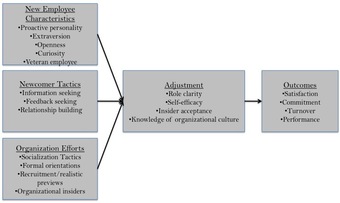
Organization Socialization Model
A model of onboarding (adapted from Bauer & Erdogan, 2011).
4.5.8: Religion
Religion is a collection of cultural systems, belief systems, and worldviews that relate humanity to spirituality and moral values.
Learning Objective
Explain how people come to be socialized in terms of religion and how parental influence is a key factor in religiosity
Key Points
- Sociology of religion is the study of the beliefs, practices, and organizational forms of religion using the tools and methods of the discipline of sociology.
- Agents of socialization differ in effects across religious traditions. Some believe religion is like an ethnic or cultural category, making it less likely for the individuals to break from religious affiliations and be more socialized in this setting.
- Belief in God is attributable to a combination of the above factors, but is also informed by a discussion of socialization. The biggest predictor of adult religiosity is parental religiosity; if a person’s parents were religious when he was a child, he is likely to be religious when he grows up.
- In their thesis, Altemeyer and Hunsberger found some interesting cases where secular people converted to religion, and religious people became secular.
Key Terms
- religion
-
an organized collection of belief systems, cultural systems, and world views that relate humanity to spirituality and, sometimes, to moral values
- sociology of religion
-
Sociology of religion is the study of the beliefs, practices, and organizational forms of religion using the tools and methods of the discipline of sociology.
- agents of socialization
-
Agents of socialization, or institutions that can impress social norms upon an individual, include the family, religion, peer groups, economic systems, legal systems, penal systems, language, and the media.
- parental religiosity
-
The biggest predictor of adult religiosity is parental religiosity; if a person’s parents were religious when he was a child, he is likely to be religious when he grows up.
Example
- In Catholic confession, a churchgoer confesses his sins to a member of the clergy. This ritual, in which the clergy responds to the churchgoer’s conduct, socializes the churchgoer to the faith’s perspective on his actions. This is an example of socialization through religion.
Religion is a collection of cultural systems, belief systems, and worldviews that relate humanity to spirituality and, sometimes, to moral values. Many religions have narratives, symbols, traditions, and sacred histories that are intended to give meaning to life or to explain the origin of life or the universe. They tend to derive morality, ethics, religious laws, or a preferred lifestyle from their ideas about the cosmos and human nature.
Sociology of religion is the study of the beliefs, practices, and organizational forms of religion, using the tools and methods of the discipline of sociology. This objective investigation may include the use of both quantitative methods (surveys, polls, demographic, and census analysis) and qualitative approaches, such as participant observation, interviewing, and analysis of archival, historical, and documentary materials.
Agents of socialization differ in effects across religious traditions. Some believe religion is like an ethnic or cultural category, making it less likely for the individuals to break from religious affiliations and be more socialized in this setting. Parental religious participation is the most influential part of religious socialization–more so than religious peers or religious beliefs. For example, children raised in religious homes are more likely to have some degree of religiosity in their lives. They are also likely to raise their own children with religion and to participate in religious ceremonies, such as baptisms and weddings.
Belief in God is attributable to a combination of the above factors but is also informed by a discussion of socialization. The biggest predictor of adult religiosity is parental religiosity; if a person’s parents were religious when he was a child, he is likely to be religious when he grows up. Children are socialized into religion by their parents and their peers and, as a result, they tend to stay in religions. Alternatively, children raised in secular homes tend not to convert to religion. This is the underlying premise of Altemeyer and Hunsberger’s main thesis–they found some interesting cases where just the opposite seemed to happen. Secular people converted to religion and religious people became secular. Despite these rare exceptions, the process of socialization is certainly a significant factor in the continued existence of religion.

Socialization through Religious Ceremonies
Religious ceremonies, such as Catholic mass, socialize members of the faith to the practices and beliefs of the religion.
4.5.9: The Division of Labor
Division of labor is the specialization of cooperative labor in specific, circumscribed tasks and similar roles.
Learning Objective
Interpret Durkheim’s division of labor theory in terms of mechanical and organic solidarity, as well as progression from primitive to advanced societies
Key Points
- An increasingly complex division of labor is historically closely associated with the growth of total output and trade, the rise of capitalism, and of the complexity of industrialization processes.
- Durkheim classified societies as primitive or advanced based on their division of labor.
- According to Durkheim, in primitive societies where there is little or no division of labor, people act and think alike with a collective conscience. In advanced societies with high division of labor, social ties are relatively homogeneous and weak.
- Labor hierarchy is a very common feature of the modern workplace structure.
- It is often agreed that the most equitable principle in allocating people within hierarchies is that of true competency or ability. This important Western concept of meritocracy could be interpreted as an explanation or as a justification of why a division of labor is the way it is.
Key Terms
- labor hierarchy
-
Labor hierarchy is a very common feature of the modern workplace structure, but of course the way these hierarchies are structured can be influenced by a variety of different factors.
- meritocracy
-
Rule by merit, and talent. By extension, now often used to describe a type of society where wealth, income, and social status are assigned through competition.
- industrialization
-
A process of social and economic change whereby a human society is transformed from a pre-industrial to an industrial state
Example
- An assembly line is an example of the division of labor.
Division of labor is the specialization of cooperative labor in specific, circumscribed tasks and roles. Historically, an increasingly complex division of labor is closely associated with the growth of total output and trade, the rise of capitalism, and of the complexity of industrialization processes. Division of labor was also a method used by the Sumerians to categorize different jobs and divide them between skilled members of a society.
Emilie Durkheim was a driving force in developing the theory of the division of labor in socialization. In his dissertation, Durkheim described how societies maintained social order based on two very different forms of solidarity (mechanical and organic), and analyzed the transition from more “primitive” societies to advanced industrial societies.
Durkheim suggested that in a “primitive” society, mechanical solidarity, with people acting and thinking alike and sharing a collective or common conscience, allows social order to be maintained. In such a society, Durkheim viewed crime as an act that “offends strong and defined states of the collective conscience”. Because social ties were relatively homogeneous and weak throughout society, the law had to be repressive and penal, to respond to offenses of the common conscience.
In an advanced, industrial, capitalist society, the complex division of labor means that people are allocated in society according to merit and rewarded accordingly; social inequality reflects natural inequality. Durkheim argued that in this type of society moral regulation was needed to maintain order (or organic solidarity). He thought that transition of a society from “primitive” to advanced may bring about major disorder, crisis, and anomie. However, once society has reached the “advanced” stage, it becomes much stronger and is done developing.
In the modern world, those specialists most preoccupied with theorizing about the division of labor are those involved in management and organization. In view of the global extremes of the division of labor, the question is often raised about what manner of division of labor would be ideal, most efficient, and most just. It is widely accepted that the division of labor is to a great extent inevitable, simply because no one can perform all tasks at once. Labor hierarchy is a very common feature of the modern workplace structure, but the structure of these hierarchies can be influenced by a variety of factors.

Division of Labor
An assembly line is a good example of a system that incorporates the division of labor; each worker is completing a discrete task to increase efficiency of overall production.
4.5.10: The Incest Taboo, Marriage, and the Family
An incest taboo is any cultural rule or norm that prohibits sexual relations between relatives.
Learning Objective
Analyze the different constructs of the incest taboo, ranging from biological (the Westermarck effect) to cultural (endogamy and exogamy)
Key Points
- Incest taboo is a cultural norm or rule that forbids sexual relations between relatives.
- Inbreeding is reproduction resulting from the mating of two genetically-related individuals.
- The Westermarck effect is essentially a psychological phenomenon that serves to discourage inbreeding. Through this effect, people who have grown up together are less likely to feel sexually attracted to one another later in life.
- Exogamy is a social arrangement in which marriage is permitted only with members from outside the social group.
- Endogamy is a social arrangement in which marriage can occur only within the same social group.
Key Terms
- inbreeding
-
Breeding between members of a relatively small population, especially one in which most members are related.
- exogamy
-
Marriage to a person belonging to a tribe or group other than your own as required by custom or law.
- endogamy
-
The practice of marrying or being required to marry within one’s own ethnic, religious, or social group.
Example
- The vast majority of people tend to feel disgust when considering incest. This emotional reaction is an example of how powerfully the incest taboo socializes individuals against interfamilial relations.
An incest taboo is any cultural rule or norm that prohibits sexual relations between relatives. All human cultures have norms regarding who is considered suitable and unsuitable as sexual or marriage partners. Usually certain close relatives are excluded from being possible partners. Little agreement exists among cultures about which types of blood relations are permissible partners and which are not. In many cultures, certain types of cousin relations are preferred as sexual and marital partners, whereas others are taboo.
One potential explanation for the incest taboo sees it as a cultural implementation of a biologically evolved preference for sexual partners without shared genes, as inbreeding may have detrimental outcomes . The most widely held hypothesis proposes that the so-called Westermarck effect discourages adults from engaging in sexual relations with individuals with whom they grew up. The existence of the Westermarck effect has achieved some empirical support. The Westermarck effect, first proposed by Edvard Westermarck in 1891, is the theory that children reared together, regardless of biological relationship, form a sentimental attachment that is by its nature non-erotic.

Inbreeding
An intensive form of inbreeding where an individual S is mated to his daughter D1, granddaughter D2 and so on, in order to maximise the percentage of S’s genes in the offspring. D3 would have 87.5% of his genes, while D4 would have 93.75%.
Another school argues that the incest prohibition is a cultural construct that arises as a side effect of a general human preference for group exogamy. Intermarriage between groups construct valuable alliances that improve the ability for both groups to thrive. According to this view, the incest taboo is not necessarily a universal, but it is likely to arise and become stricter under cultural circumstances that favor exogamy over endogamy; it likely to become more lax under circumstances that favor endogamy. This hypothesis has also achieved some empirical support.
Societies that are stratified often prescribe different degrees of endogamy. Endogamy is the opposite of exogamy; it refers to the practice of marriage between members of the same social group. A classic example is seen in India’s caste system, in which unequal castes are endogamous. Inequality between ethnic groups and races also correlates with endogamy. Class, caste, ethnic and racial endogamy typically coexists with family exogamy and prohibitions against incest.
4.5.11: Ideology
Ideology is a coherent system of ideas that constitutes one’s goals, expectations, and actions.
Learning Objective
Explain the purpose of an ideology and how it is used in various contexts (i.e. religion or politics) to create change or conformity in society
Key Points
- Ideology can be used either to initiate change in society or to encourage continued adherence to a set of ideals in a situation where conformity already exists.
- According to Karl Marx, ideology is an instrument for social reproduction, as those who control the means of production (the ruling class) are able to establish the dominant ideology within a society.
- Louis Althusser proposed a materialistic conception of ideology using the concept of Ideological State Apparatus.
- Ideological State Apparatuses are institutions, such as the family, media, religious organizations, education system, etc., that together comprise ideological practice, the sphere which has the defining property of constituting individuals as subjects.
- Many political parties base their political action and program on an ideology. Political ideology consists of two dimensions: goals and methods.
Key Terms
- superstructure
-
The ideas, philosophies, and culture that are built upon the means of production.
- ideology
-
the doctrine, philosophy, body of beliefs or principles belonging to an individual or group
An ideology is a set of ideas that constitute one’s goals, expectations, and actions. An ideology can be thought of as a comprehensive vision, as a way of looking at things, as in several philosophical tendencies, or a set of ideas proposed by the dominant class of a society to all members of this society. The main purpose behind an ideology is to offer either change in society, or adherence to a set of ideals where conformity already exists, through a normative thought process. Ideologies are systems of abstract thought applied to public matters and thus make this concept central to politics.
In the Marxist account of ideology, it serves as an instrument of social reproduction. In the Marxist economic base and superstructure model of society, base denotes the relations of production, and superstructure denotes the dominant ideology (religious, legal, political systems). The economic base of production determines the political superstructure of a society. Ruling class-interests determine the superstructure and the nature of the justifying ideology—actions feasible because the ruling class control the means of production. Similarly, Louis Althusser proposed a materialistic conception of ideology using the concept of the ideological state apparatus. For Althusser, beliefs and ideas are the products of social practices, not the reverse. What is ultimately important for Althusser are not the subjective beliefs held in the “minds” of human individuals, but rather the material institutions, rituals, and discourses that produce these beliefs.
Many political parties base their political action and program on an ideology. A political ideology is a certain ethical set of ideals, principles, doctrines, myths, or symbols of a social movement, institution, class, or large group that explains how society should work and offers some political and cultural blueprint for a certain social order. A political ideology largely concerns itself with how to allocate power and to what ends it should be used. Some parties follow a certain ideology very closely, while others may take broad inspiration from a group of related ideologies without specifically embracing any one of them.
4.5.12: Resocialization and Total Institutions
A total institution is a place where a group of people is cut off from the wider community and their needs are under bureaucratic control.
Learning Objective
Review Goffman’s five types of social institutions and their functions, including their processes of resocialization
Key Points
- The term total institution was coined by the American sociologist Erving Goffman.
- Resocialization is defined as radically changing an inmate’s personality by carefully controlling his or her environment.
- Resocialization is a two-part process. First, the staff of the institution tries to erode the residents’ identities and independence. Second, the resocialization process involves the systematic attempt to build a different personality or self.
Key Terms
- total institution
-
It is an institution that controls almost all aspects of its members’ lives. Boarding schools, orphanages, military branches, juvenile detention, and prisons are examples of total institutions.
- Erving Goffman
-
Erving Goffman (June 11, 1922 – November 19, 1982) was a Canadian-born sociologist and writer. The 73rd president of American Sociological Association, Goffman’s greatest contribution to social theory was his study of symbolic interaction in the form of dramaturgical analysis. This began with his 1959 book, The Presentation of Self in Everyday Life.
- Resocialization
-
Resocialization is defined as radically changing an inmate’s personality by carefully controlling the environment.
A total institution is a place of work and residence where a great number of similarly situated people, cut off from the wider community for a considerable time, lead an enclosed, formally administered life together. The term was coined by the American sociologist Erving Goffman. Within a total institution, the basic needs of a entire bloc of people are under bureaucratic control. These needs are handled in an impersonal and bureaucratic manner.
Goffman divided total institutions into five different types:
- Institutions established to care for harmless or incapable people, including orphanages, poor houses and nursing homes
- Institutions established to care for people that are incapable of looking after themselves and are also a threat to the community, including leprosarium, mental hospitals, and tuberculosis sanitariums
- Institutions organized to protect the community against perceived intentional dangers, with the welfare of the sequestered people not the immediate issue, including concentration camps, prisoner of war camps, penitentiaries and jails
- Institutions purportedly established to pursue some task, including colonial compounds, work camps, boarding schools, and ships
- Institutions designed as retreats from the world while also often serving as training stations for the religious, including convents, abbeys, and monasteries
The goal of total institutions is resocialization, the radical alteration of residents’ personalities by deliberately manipulating their environment. Key examples include the process of resocializing new recruits into the military so that they can operate as soldiers. Resocialization is a two-part process. First, the staff of the institution tries to erode the residents’ identities and independence. Second, resocialization involves the systematic attempt to build a different personality or self. This is generally done through a system of reward and punishment. The privilege of reading a book, watching television, or making a phone call can be a powerful motivator to conform. Conformity occurs when individuals change their behavior to fit in with the expectations of an authority figure or the expectations of a larger group.

Total Institutions
Prisons are examples of total institutions.
4.6: Gender Socialization
4.6.1: Gender Socialization
Gender socialization is the process of teaching people how to behave as men or women.
Learning Objective
Analyze how the process of gender socialization has an impact on the lifespan development of a person, specifically related to stereotypes between men and women
Key Points
- Gender socialization begins even before a baby is born.
- Gender is socialized through media messages, school instruction, family expectations, and experiences in the workplace.
- The process of gender socialization continues as adolescents enter the workforce. Research has found that adolescents encounter stereotypes of gendered performance in their first jobs.
Key Term
- gender
-
The socio-cultural phenomenon of the division of people into various categories such as male and female, with each having associated roles, expectations, stereotypes, etc.
Examples
- Disney movies present clear narratives of how men and women are supposed to behave, socializing young children.
- Disney movies present clear narratives of how men and women are supposed to behave, socializing young children.
Sociologists and other social scientists generally attribute many of the behavioral differences between men and women to socialization. Socialization is the process of transferring norms, values, beliefs, and behaviors to future group members. In regards to gender socialization, the most common groups people join are the gender categories male and female. Even the categorical options of gender an individual may choose is socialized; social norms act against selecting a gender that is neither male or female. Thus, gender socialization is the process of educating and instructing potential men and women how to behave as members of that particular group.
Socialization Before Birth
Preparations for gender socialization begin even before the birth of the child. One of the first questions people ask of expectant parents is whether the baby will be a boy or girl. This is the beginning of a social categorization process that continues throughout life. Preparations for the birth of the child often take the expected sex into consideration, such as painting the infant’s room pink or blue.
Early Life Socialization
One illustration of early life gender socialization can be seen in preschool classrooms. Children in preschool classrooms where teachers were told to emphasize gender differences saw an increase in stereotyped views of what activities are appropriate for boys or girls, while children with teachers who did not emphasize gender showed no increase in stereotyped views. This clearly demonstrates the influence of socialization on the development of gender roles; subtle cues that surround us in our everyday lives strongly influence gender socialization.
Adolescent Socialization
The process of gender socialization continues as adolescents enter the workforce. Research has found that adolescents encounter stereotypes of gendered performance in the workforce in their first jobs. First jobs are significantly segregated by sex. Girls work fewer hours and earn less per hour than boys. Hourly wages are higher in job types dominated by boys while girls are more frequently assigned housework and childcare duties. The impact of these first experiences in the professional world will shape adolescents’ perspectives on how men and women behave differently in the workforce.

Gender Socialization in Infants
Preparations for the birth of the child often take the expected sex into consideration, such as painting the infant’s room pink or blue.
4.6.2: Learning the Gender Gap
The gender pay gap, or the difference between male and female earnings, is primarily due to discriminatory social processes.
Learning Objective
Discuss the impact the gener pay/wage gap can have on both men and, in particular, women, in the economic world
Key Points
- There is a debate as to what extent the gender pay gap is the result of gender differences, implicit discrimination due to lifestyle choices, or because of explicit discrimination.
- The unadjusted wage gap refers to a measure of the wage gap that does not take into account differences in personal and workplace characteristics between men and women.
- We can assume that the adjusted wage gap represents the gap due to implicit discrimination. In other words, the social forces that cause women to stay home with children more frequently than men or to be less aggressive, are responsible for this part of the wage gap.
- The difference between the unadjusted and the adjusted wage gap is due to explicit discrimination or the fact that on average, a woman will make less than an identical man in the exact same occupation.
- Studies have shown that the majority of the gender wage gap is due to implicit, not explicit, discrimination.
Key Terms
- The gender pay gap
-
The gender pay gap is the difference between male and female earnings expressed as a percentage of male earnings, according to the OECD.
- glass ceiling
-
An unwritten, uncodified barrier to further promotion or progression for a member of a specific demographic group.
Example
- Men are paid more per hour and are promoted more frequently than women, both examples of the gender pay gap.
The gender pay gap is the difference between male and female earnings expressed as a percentage of male earnings, according to the Organisation for Economic Co-operation and Development (OECD). The European Commission defines it as the average difference between men and women’s hourly earnings. There is a debate as to what extent this is the result of gender differences, implicit discrimination due to lifestyle choices, or because of explicit discrimination. If it is a result of gender differences, then the pay gap is not a problem; men are simply better equipped to perform more valuable work than women. If it is a result of implicit discrimination due to lifestyle choices, then women’s lower earnings result from the fact that women typically take more time off when having children or choose to work fewer hours. If it is explicit discrimination, then the pay gap is a result of stereotypical beliefs, conscious or unconscious, from those who hire and set salaries.
Most who study the gender wage gap assume that it is not due to differences in ability between genders – while in general men may be better at physical labor, the pay gap persists in other employment sectors as well. This implies that the gender gap stems from social, rather than biological, origins.
In order to determine whether the gender gap is a result of implicit or explicit discrimination, we can look at the adjusted and unadjusted wage gap. The unadjusted wage gap refers to a measure of the wage gap that does not take into account differences in personal (e.g., age, education, the number of children, job tenure, occupation, and occupational crowding) and workplace (e.g., the economic sector and place of employment) characteristics between men and women. Parts of the raw pay gap can be attributed to the fact that women, for instance, tend to engage more often in part-time work and tend to work in lower paid industries. The remaining part of the raw wage gap that cannot be explained by variables that are thought to influence pay is then referred to as the adjusted gender pay gap and may be explicitly discriminatory.
The total wage gap in the United States is 20.4 percent. A study commissioned by the United States Department of Labor, prepared by Consad Research Corp, asserts that there are “observable differences in the attributes of men and women that account for most of the wage gap. Statistical analysis that includes those variables has produced results that collectively account for between 65.1 and 76.4 percent of a raw gender wage gap of 20.4 percent, and thereby leave an adjusted gender wage gap that is between 4.8 and 7.1 percent. ” Thus, only a relatively small part of the wage gap is due to explicit discrimination .

Gender Pay Gap in the United States, 1980-2009
This graph depicts the female-to-male earnings ratio, median yearly earnings among full-time, year-round workers from 1980 to 2009.
We can assume that the remainder (the gap attributed to the measured variables) is the result of implicit discrimination, that is, social forces that pressure women into working part time, to stay home with their children, to be less aggressive in pursuing promotions or raises, etc. A 2010 report by the European Foundation for the Improvement of Living and Working Conditions, for example, pointed out that “the major reasons for this gap are very often related to both horizontal and vertical segregation – or the fact that women tend to choose lower-paid professions, reach a ‘glass ceiling’ in their careers, or have their jobs valued less favourably. The origins of these factors could be judged as being discriminatory in themselves, that is, when they are rooted in gender stereotypes of male and female occupations . “
4.6.3: Gender Messages in the Family
Gender role theory posits that boys and girls learn the appropriate behavior and attitudes from the family with which they grow up.
Learning Objective
Justify how the family acts as the most important agent of gender socialization for children and adolescents
Key Points
- Primary socialization – the socialization that occurs during childhood and depends mostly on a child’s family members – is typically the most long-lasting and influential phase of socialization. Therefore, the gender roles learned from family will endure.
- The family is the most important agent of socialization because it serves as the center of the child’s life.
- The division of labor between men and women contributes to the creation of gender roles, which in turn, lead to gender-specific social behavior.
- In the adult years the demands of work and family overwhelm most peer group relations and the influence of peers seriously declines as an agent of socialization, only to return during the elderly years.
- The division of labor creates gender roles, which in turn, lead to gendered social behavior.
Key Terms
- primary socialization
-
The socialization that takes place early in life, as a child and adolescent.
- Division of labor
-
A division of labour is the dividing and specializing of cooperative labour into specifically circumscribed tasks and roles.
- gender role theory
-
The idea that boys and girls learn the behavior and attitudes about how to perform one’s biologically assigned gender.
Example
- Families divide responsibilities between parents. In many American families, the father serves as the breadwinner, while the mother maintains the household. This teaches their children that the expected gender roles for men and women require the father to work and the mother to remain in the domestic sphere.
Gender role theory posits that boys and girls learn the appropriate behavior and attitudes from the family and overall culture in which they grow up, and that non-physical gender differences are a product of socialization. Social role theory proposes that social structure is the underlying force behind gender differences, and that the division of labor between two sexes within a society motivates the differences in their respective behavior. Division of labor creates gender roles, which in turn, lead to gender-specific social behavior.
Family is the most important agent of socialization because it serves as the center of a child’s life. Socialization theory tells us that primary socialization – the process that occurs when a child learns the attitudes, values and actions expected of individuals within a particular culture – is the most important phase of social development, and lays the groundwork for all future socialization. Therefore, the family plays a pivotal role in the child’s development, influencing both the attitudes the child will adopt and the values the child will hold. Socialization can be intentional or unintentional; the family may not be conscious of the messages it transmits, but these messages nonetheless contribute to the child’s socialization. Children learn continuously from the environment that adults create, including gender norms.
For example, a child who grows up in a two-parent household with a mother who acts as a homemaker and a father who acts as the breadwinner may internalize these gender roles, regardless of whether or not the family is directly teaching them. Likewise, if parents buy dolls for their daughters and toy trucks for their sons, the children will learn to value different things.
4.6.4: Gender Messages from Peers
Peer groups can serve as a venue for teaching gender roles, especially if conventional gender social norms are strongly held.
Learning Objective
Discuss how peer groups can have a major impact on the gender socialization of a person, particularly children and adolescents
Key Points
- Gender roles refer to the set of social and behavioral norms that are considered socially appropriate for individuals of a specific sex in the context of a specific culture.
- Through gender-role socialization, group members learn about sex differences, and social and cultural expectations.
- Early on, children begin to almost restrict themselves to same-gendered groups. Boys tend to participate in more active and forceful activities in larger groups, away from adults, while girls were more likely to play in small groups, near adults.
- The stereotypes are less prominent when the groups are mixed-gendered, because the difference is not salient.
- A girl who wishes to take karate class instead of dance lessons may be called a “tomboy,” facing difficulty gaining acceptance from both male and female peer groups.
Key Terms
- gender roles
-
Sets of social and behavioral norms that are generally considered appropriate for either a man or a woman in a social or interpersonal relationship.
- stereotype
-
A conventional, formulaic, and oversimplified conception, opinion, or image of a group of people or things.
- Peer groups
-
Peer groups can serve as a venue for teaching members gender roles.
Example
- If a boy acts “too feminine,” he may be called a sissy and have difficulty gaining acceptance from other boys. If a girl acts “too masculine,” she may be called a tomboy and have difficulty gaining acceptance from other girls.
Gender role theory posits that boys and girls learn the appropriate behavior and attitudes from the family and overall culture in which they grow up, and so non-physical gender differences are a product of socialization. Social role theory proposes that the social structure is the underlying force for gender differences. Social role theory proposes that sex-differentiated behavior is motivated by the division of labor between two sexes within a society. Division of labor creates gender roles, which in turn lead to gendered social behavior.
Peer groups can serve as a venue for teaching members gender roles. Gender roles refer to the set of social and behavioral norms that are considered socially appropriate for individuals of a specific sex in the context of a specific culture, and which differ widely across cultures and historical periods.
Through gender-role socialization, group members learn about sex differences, and social and cultural expectations. Biological males are not always masculine and biological females are not always feminine. Both genders can contain different levels of masculinity and femininity. Peer groups can consist of all males, all females, or both males and females.
Peer groups can have great influence on each other’s gender role behavior depending on the amount of pressure applied. If a peer group strongly holds to a conventional gender social norm, members will behave in ways predicted by their gender roles, but if there is not a unanimous peer agreement, gender roles do not correlate with behavior. There is much research that has been done on how gender affects learning within student peer groups. The purpose of a large portion of this research has been to see how gender affects peer cooperative groups, how that affects the relationships that students have within the school setting, and how gender can then affect attainment and learning. One thing that is an influence on peer groups is student behavior.
Knowing early on that children begin to almost restrict themselves to same-gendered groups, it is interesting to see how those interactions within groups take place. Boys tend to participate in more active and forceful activities in larger groups, away from adults, while girls were more likely to play in small groups, near adults. These gender differences are also representative of many stereotypical gender roles within these same-gendered groups. The stereotypes are less prominent when the groups are mixed-gendered.
When children do not conform to the appropriate gender role, they may face negative sanctions such as being criticized or marginalized by their peers. Though many of these sanctions are informal, they can be quite severe. For example, a girl who wishes to take karate class instead of dance lessons may be called a “tomboy,” facing difficulty gaining acceptance from both male and female peer groups. Boys, especially, are subject to intense ridicule for gender nonconformity.
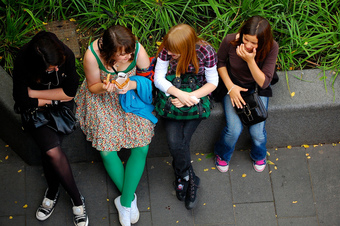
Female Peer Groups
Teenage cliques exert influence upon their members to conform to group standards, including group mores about gender.
4.6.5: Gender Messages in Mass Media
In mass media, women tend to have less significant roles than men, and are often portrayed in stereotypical roles, such as wives or mothers.
Learning Objective
Discuss the types of gender socialization people get from viewing various types of media
Key Points
- Gender socialization occurs through four major agents: family, education, peer groups, and mass media.
- Television commercials and other forms of advertising reinforce inequality and gender-based stereotypes.
- Particularly concerning are instances when women are depicted in dehumanizing, violent, and oppressive ways, especially in music videos.
- The mass media is able to deliver impersonal communications to a vast audience.
Key Terms
- Gender socialization
-
The process of educating and instructing males and females as to the norms, behaviors, values, and beliefs of group membership as men or women.
- impersonal communications
-
The mass media are the means for delivering impersonal communications directed to a vast audience, and include radio, advertising, television, and music.
- television commercials
-
Television commercials and other forms of advertising also reinforce inequality and gender-based stereotypes.
Example
- An example of a music video spreading gender norms is the video for 50 Cent’s “Pimp. ” Much like most other rap music videos, women appear as servile, scantily-clad objects that exist chiefly to serve men.
Gender socialization occurs through four major agents: family, education, peer groups, and mass media. Because mass media has enormous effects on our attitude and behavior, notably in regards to aggression, it is an important contributor to the socialization process. This is particularly true with regards to gender. In television and movies, women tend to have less significant roles than men. They are often portrayed as wives or mothers, rather than as main characters. When women are given a lead role, they are often one of two extremes: either a wholesome, saint-like figure or a malevolent, hyper-sexual figure. This same inequality is similarly pervasive in children’s movies. Research indicates that among the 101 top-grossing, G-rated movies released between 1990 and 2005, three out of every four characters were male. Out of those movies, only seven films were even close to having a balanced cast of characters, with a ratio of less than 1.5 male characters per 1 female character.
Television commercials and other forms of advertising reinforce inequality and gender-based stereotypes. Women almost exclusively appear in ads that promote cooking, cleaning, or childcare-related products. In general, women are underrepresented in roles, or ads, that reference leadership, intelligence, or a balanced psyche. Particularly concerning are instances when women are depicted in dehumanizing, oppressive ways, especially in music videos. The music video for “Pimp,” a song by 50 Cent, Snoop Dogg, and G-Unit, demonstrates how harmful gender messages can be disseminated through mass media. In the video, women are objectified and portrayed as only existing to serve men. They wear little clothing and are walked around on leashes by men, as if they were dogs and not humans.

Gender Messages in Mass Media
Traditional images of American gender roles reinforce the idea that women should be subordinate to men.
4.7: Socialization Throughout the Life Span
4.7.1: Socialization Throughout the Life Span
Socialization is the lifelong process of preparing an individual to live within his or her own society.
Learning Objective
Discuss the concept of both primary and secondary socialization as a lifelong process which begins in infancy and continues into late adulthood
Key Points
- Socialization is the lifelong process of inheriting and disseminating norms, customs and ideologies, providing an individual with the skills and habits necessary for participating within his or her own society.
- Socialization is the process by which human infants acquire the skills necessary to perform as a functioning member of their society, a process that continues throughout an individual’s life.
- The socialization process can be divided into primary and secondary socialization. Primary socialization occurs when a child learns the attitudes, values and actions appropriate to individuals as members of a particular culture. This is mainly influenced by the immediate family and friends.
- Secondary socialization is the process of learning what is the appropriate behavior as a member of a smaller group within the larger society. It is the behavioral patterns reinforced by socializing agents of society. like schools and workplaces.
- The life course approach was developed in the 1960s for analyzing people’s lives within structural, social and cultural contexts.
Key Terms
- socialization
-
The process of learning one’s culture and how to live within it.
- agent
-
One who exerts power, or has the power to act; an actor.
Example
- Any study that focuses on how cultural context influences individual development is an example of the life course approach. An example would be Erving Goffman’s work Asylum, which discusses how individuals are molded by institutions.
Socialization refers to the lifelong process of inheriting and disseminating norms, customs and ideologies that provide an individual with the skills necessary for participating within society. Socialization is a process that continues throughout an individual’s life. Some social scientists say socialization represents the process of learning throughout life and is a central influence on the behavior, beliefs and actions of adults as well as of children.
George Herbert Mead (1902–1994) developed the concept of self as developed with social experience. Since social experience is the exchange of symbols, people find meaning in every action, and seeking meaning leads people to imagine the intention of others from the others’ point of view. In effect, others are a mirror in which we can see ourselves. Charles Horton Cooley (1902-1983) coined the term “looking glass self;” the self-image based on how we think others see us. According to Mead, the key to developing the self is learning to take the role of the other. With limited social experience, infants can only develop a sense of identity through imitation. Children gradually learn to take the roles of several others. The final stage is the generalized other; the widespread cultural norms and values we use as a reference for evaluating others.
Primary and Secondary Socialization
The socialization process can be divided into primary and secondary socialization. Primary socialization occurs when a child learns the attitudes, values and actions appropriate to individuals as members of a particular culture. This is mainly influenced by the immediate family and friends. Secondary socialization is the process of learning what is the appropriate behavior as a member of a smaller group within the larger society. It is the behavioral patterns reinforced by socializing agents of society like schools and workplaces. For example, as new employees become socialized in an organization, they learn about its history, values, jargon, culture and procedures.
The Life Course Approach
The life course approach was developed in the 1960s for analyzing people’s lives within structural, social and cultural contexts. Origins of this approach can be traced to such pioneering studies as Thomas’s and Znaniecki’s “The Polish Peasant in Europe and America” from the 1920s or Mannheim’s essay on the “Problem of generations. ” The life course approach examines an individual’s life history and how early events influence future decisions.
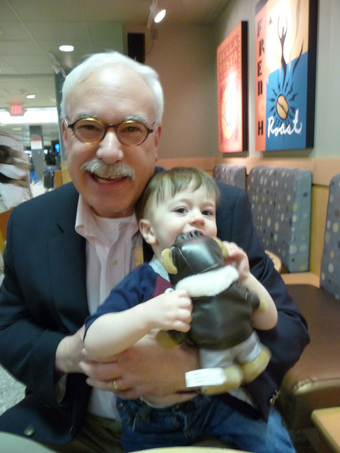
Life Course Approach
The life course approach studies the impact that sociocultural contexts have on an individual’s development, from infancy until old age.
4.7.2: The Life Course
The life course approach analyzes people’s lives within structural, social, and cultural contexts.
Learning Objective
Explain the life course perspective as it relates to a person’s development from infancy to old age, in terms of structural, social and cultural contexts
Key Points
- The life course approach refers to an approach developed in the 1960s for analyzing people’s lives within structural, social, and cultural contexts.
- The life course approach examines an individual’s life history and sees for example how early events influence future decisions and events, giving particular attention to the connection between individuals and the historical and socioeconomic context in which they lived.
- In a more general reading of the life course, human life is seen as divided into stages, which are somewhat arbitrary, but capture periods of life that are similar across cultures. These stages of life often inform and are reinforced by legal definitions of life stages.
Key Terms
- life course
-
the sequence of events, roles and age categories that people pass through from birth until death, all of which are culturally defined
- age
-
Mature age; especially, the time of life at which one attains full personal rights and capacities.
- socioeconomic
-
Of or pertaining to social and economic factors.
The life course approach, also known as the life course perspective, or life course theory, refers to an approach developed in the 1960s for analyzing people’s lives within structural, social, and cultural contexts. Origins of this approach can be traced to pioneering studies such as Thomas’s and Znaniecki’s “The Polish Peasant in Europe and America” from the 1920s or Mannheim’s essay on the “Problem of generations”.
The life course approach examines an individual’s life history and sees for example how early events influence future decisions and events, giving particular attention to the connection between individuals and the historical and socioeconomic context in which they have lived. It holds that the events and roles that are part of the person’s life course do not necessarily proceed in a given sequence, but rather constitute the sum total of the person’s actual experience.
In a more general reading, human life is seen as often divided into various age spans such as infancy, toddler, childhood, adolescence, young adult, prime adulthood, middle age, and old age . These divisions are somewhat arbitrary, but generally capture periods of life that reflect a certain degree of similarity in development across cultures.

Old Age
This man is well into his later years and depicts life in its final stages.
In many countries, such as Sweden and the United States, adulthood legally begins at the age of eighteen. This is a major age milestone that is marked by significantly different attitudes toward the person who undergoes the transition. This is an example that demonstrates the influence of developmental stages on legal determinations of life stages, and thus, attitudes towards people at different stages of the human life course.
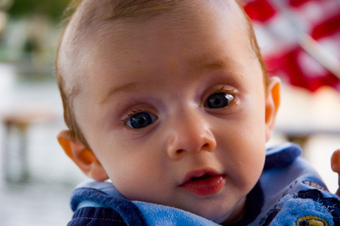
Infant
This picture depicts an individual at the earliest of life stages.
4.7.3: Anticipatory Socialization and Resocialization
Anticipatory socialization comes from an individual’s desire to join a group while resocialization is imposed upon an individual by a group.
Learning Objective
Explain the two steps associated with the resocialization process and how people use anticipatory socialization as a means to gain entrance into desired social groups
Key Points
- Anticipatory socialization is the process of changing one’s attitudes and behaviors in preparation for a shift in one’s role.
- The process of anticipatory socialization is facilitated by social interactions with the group they aspire to join.
- Resocialization is radically changing an inmate’s personality by carefully controlling their environment.
- Resocialization is a two-part process. First, the staff of the institution tries to erode the residents’ identities and independence. Second, there is a systematic attempt to build a different personality or self.
Key Terms
- Anticipatory socialization
-
Anticipatory socialization is the process, facilitated by social interactions, in which non-group-members learn to take on the values and standards of groups that they aspire to join, so as to ease their entry into the group and help them interact competently once they have been accepted by it.
- Social interactions
-
It refers to a relationship between two (i.e. a dyad), three (i.e. a triad) or more individuals (e.g. a social group).
Example
- An example of anticipatory socialization includes law school students learning how to behave like lawyers. An example of resocialization is the process of bringing new recruits into the military.
Anticipatory Socialization
Anticipatory socialization is the process by which non-group-members adopt the values and standards of groups that they aspire to join, so as to ease their entry into the group and help them interact appropriately once they have been accepted. It involves changing one’s attitudes and behaviors in preparation for a shift in one’s role. Practices commonly associated with anticipatory socialization include grooming, play-acting, training, and rehearsing. Examples of anticipatory socialization include law school students learning how to behave like lawyers, older people preparing for retirement, and Mormon boys getting ready to become missionaries.
Anticipatory socialization was first defined by sociologist Robert K. Merton. It has its origins in a 1949 study of the United States military which found that privates who modeled their attitudes and behaviors on those of officers were more likely to be promoted than those who did not.
When people are blocked from access to a group they might have wanted to join, they reject that group’s values and norms. Instead, they begin an anticipatory socialization process with groups that are more receptive to them. One example of this is the case of economically disadvantaged teenagers who seek to become drug dealers rather than professionals. While some critics would claim that these individuals lack motivation, some sociologists say they are simply making a pragmatic adjustment to the opportunities available to them.
Resocialization
Resocialization is defined as radically changing someone’s personality by carefully controlling their environment. Total institutions aim to radically alter residents’ personalities through deliberate manipulation of their environment. Key examples include the process of resocializing new recruits into the military so that they can operate as soldiers (or, in other words, as members of a cohesive unit) and the reverse process, in which those who have become accustomed to such roles return to society after military discharge. Resocialization may also be required for inmates who come out of prison and need to acclimate themselves back into civilian life.
Resocialization is a two-part process. First, the staff of the institution tries to erode the residents’ identities and sense of independence. Strategies include forcing individuals to surrender all personal possessions, cut their hair in a uniform manner, and wear standardized clothing. Independence can be eroded by subjecting residents to humiliating and degrading procedures. Examples include strip searches, fingerprinting, and replacing residents’ given names with serial numbers or code names. Second, resocialization involves the systematic attempt to build a different personality or self. This is generally accomplished through a system of rewards and punishments. The privilege of reading a book, watching television, or making a phone call can be powerful motivation to conform. Conformity occurs when individuals change their behavior to fit the expectations of an authority figure or the expectations of a larger group.

Guitar Lessons
The young woman is interacting with her professor in anticipation of being associated with other guitarists
4.7.4: Stages of Socialization Throughout the Life Span
The socialization process can be separated into two main stages: primary socialization and secondary socialization.
Learning Objective
Give examples of how the socialization process progresses throughout a person’s life
Key Points
- The life process of socialization is generally divided into two parts: primary and secondary socialization.
- Primary socialization takes place early in life, as a child and adolescent. This is when an individual develops their core identity.
- Secondary socialization takes place throughout an individual’s life, both as a child and as one encounters new groups. This involves more specific changes in response to the acquisition of new group memberships and roles and differently structured social situations.
- Some of the more significant contributors to the socialization process are: parents, guardians, friends, schools, siblings or other family members, social clubs (like religions or sports teams), life partners (romantic or platonic), and co-workers.
Key Terms
- primary socialization
-
The socialization that takes place early in life, as a child and adolescent.
- secondary socialization
-
The socialization that takes place throughout one’s life, both as a child and as one encounters new groups that require additional socialization.
Socialization is a life process, but is generally divided into two parts: primary and secondary socialization.
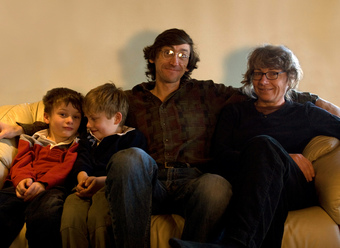
Primary Socialization
The nuclear family serves as the primary force of socialization for young children.
Primary socialization takes place early in life, as a child and adolescent. Secondary socialization refers to the socialization that takes place throughout one’s life, both as a child and as one encounters new groups that require additional socialization. While there are scholars who argue that only one or the other of these occurs, most social scientists tend to combine the two, arguing that the basic or core identity of the individual develops during primary socialization, with more specific changes occurring later—secondary socialization—in response to the acquisition of new group memberships and roles and differently structured social situations. The need for later-life socialization may stem from the increasing complexity of society with its corresponding increase in varied roles and responsibilities.
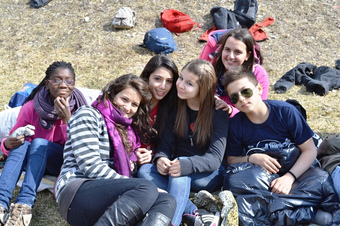
Secondary Socialization
By the time individuals are in their preteen or teenage years, peer groups play a more powerful role in socialization than family members.
Mortimer and Simmons outline three specific ways these two parts of socialization differ:
- Content: Socialization in childhood is thought to be concerned with the regulation of biological drives. In adolescence, socialization is concerned with the development of overarching values and the self-image. In adulthood, socialization involves more overt and specific norms and behaviors, such as those related to the work role as well as more superficial personality features.
- Context: In earlier periods, the socializee (the person being socialized) more clearly assumes the status of learner within the context of the initial setting (which may be a family of orientation, an orphanage, a period of homelessness, or any other initial social groups at the beginning of a child’s life), the school (or other educational context), or the peer group. Also, relationships in the earlier period are more likely to be affectively charged, i.e., highly emotional. In adulthood, though the socializee takes the role of student at times, much socialization occurs after the socializee has assumed full incumbency of the adult role. There is also a greater likelihood of more formal relationships due to situational contexts (e.g., work environment), which moderates down the affective component.
- Response: The child and adolescent may be more easily malleable than the adult. Also, much adult socialization is self-initiated and voluntary; adults can leave or terminate the process at any time if they have the proper resources (symbolic, financial, and social) to do so.
Socialization is, of course, a social process. As such, it involves interactions between people. Socialization, as noted in the distinction between primary and secondary, can take place in multiple contexts and as a result of contact with numerous groups. Some of the more significant contributors to the socialization process are: parents, guardians, friends, schools, siblings or other family members, social clubs (like religions or sports teams), life partners (romantic or platonic), and co-workers. Each of these groups include a culture that must be learned and to some degree appropriated by the socializee in order to gain admittance to the group.
4.7.5: Childhood
Childhood has been constructed in different ways over time, though modern childhood is often defined by play, learning and socializing.
Learning Objective
Evaluate the importance of childhood (early, middle and adolescence) in terms of socialization and acceptance in society
Key Points
- Contemporary conceptions of childhood generally divide the period into three main stages: early childhood (toddlerhood), middle childhood, and adolescence.
- Childhood is not an absolute concept defined by age and experience. Instead, childhood as a concept has been conceived in very different manners over time.
- American culture figures outdoor play as an essential part of childhood, though the reality is that children are increasingly playing indoors.
Key Terms
- middle childhood
-
It is the school age and begins at around seven or eight.
- adolescence
-
The transitional period of physical and psychological development between childhood and maturity.
- toddlerhood
-
The period of one’s life in which one is a toddler
Childhood is the age span ranging from birth to adolescence. In developmental psychology, childhood is divided up into the developmental stages of toddlerhood (learning to walk), early childhood (play age), middle childhood (school age), and adolescence (puberty through post-puberty).
Age Ranges of Childhood
The term childhood is non-specific and can imply a varying range of years in human development, depending on biological, personal, religious, cultural, or national interpretations. Developmentally and biologically, it refers to the period between infancy and puberty. In common terms, childhood is considered to start from birth. Some consider that childhood, as a concept of play and innocence, ends at adolescence. In the legal systems of many countries, there is an age of majority at which point childhood officially ends and a person legally becomes an adult. Globally, the age of majority ranges anywhere from 15 to 21, with 18 being the most common.
Developmental Stages of Childhood
Early childhood follows the infancy stage and begins with toddlerhood, reached when the child begins speaking or taking steps independently. Toddlerhood ends around age three when the child becomes less dependent on parental assistance for basic needs and early childhood continues approximately through years seven or eight. According to the National Association for the Education of Young Children, early childhood spans the from birth to age eight.
In most western societies, middle childhood begins at around age seven or eight, approximating primary school age and ends around puberty, which typically marks the beginning of adolescence.
Adolescence is usually determined by the onset of puberty. However, puberty may also begin in preadolescents. The end of adolescence and the beginning of adulthood varies by country. Even within a single nation-state or ethic group there may be different conceptions of when an individual is considered to be (chronologically and legally) mature enough to be entrusted by society with certain tasks.
Modern Concepts of Childhood
The concept of childhood appears to evolve and change shape as lifestyles change and adult expectations alter. Some believe that children should not have any worries and should not have to work; life should be happy and trouble-free. Childhood is generally a time of playing, learning, socializing, exploring, and worrying in a world without much adult interference, aside from parents. It is a time of learning about responsibilities without having to deal with adult responsibilities.
Childhood is often retrospectively viewed as a time of innocence. According to this view, children have yet to be negatively influenced by society and are naive, rather than ignorant. A “loss of innocence” is a common concept, and is often seen as an integral part of coming of age. It is usually thought of as an experience or period in a child’s life that widens their awareness of evil, pain or the world around them. This theme is demonstrated in the novels To Kill a Mockingbird and Lord of the Flies. The fictional character Peter Pan is the embodiment of a childhood that never ends.
Play
Play is essential to the cognitive, physical, social, and emotional well-being of children. It offers children opportunities for physical (running, jumping, climbing, etc.), intellectual (social skills, community norms, ethics, and general knowledge) and emotional development (empathy, compassion, and friendships). Unstructured play encourages creativity and imagination and allows children to interact with the world around them. Playing and interacting with other children, as well as with some adults, provides opportunities for friendships, social interactions, practicing adult roles, and resolving conflicts.

Play
Play is essential for the cognitive, physical, and social wellbeing of children.
Undirected play allows children to learn how to work in groups, to share, to negotiate, to resolve conflicts, and to learn self-advocacy skills. However, when play is controlled by adults, children acquiesce to adult rules and concerns and lose some of the benefits play offers them, particularly in developing creativity, leadership, and group skills.
Play is considered to be so important to optimal child development that it has been recognized by the United Nations High Commission for Human Rights as a right of every child. Raising children in a hurried and pressured style may limit the benefits they would gain from child-driven play.
American culture considers outdoor play as an essential part of childhood. However, the reality is that children are increasingly playing indoors. Nature Deficit Disorder, a term coined by Richard Louv in his 2005 book Last Child in the Woods, refers to the alleged trend in the United States that children are spending less time outdoors, resulting in a wide range of behavioral problems. With the advent of the computer, video games, and television, children have more reasons to stay inside rather than outdoors exploring. On average, American children spend forty-four hours per week with electronic media. Parents are also keeping children indoors in order to protect them from their growing fear of stranger danger.
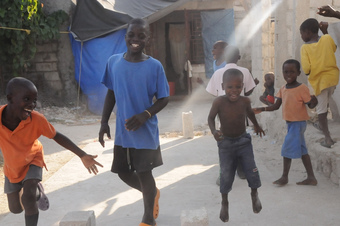
Kids playing in the street
Children street culture transforms seemingly normal places into imaginative worlds
4.7.6: Adolescence
Adolescence is a period of significant cognitive, physical and social development, including changes in family and peer relationships.
Learning Objective
Discuss the influences on, and significance of, adolescent socialization and development, culminating in the development of autonomy
Key Points
- In addition to biological and social development, adolescents are also subject to a varied experiences across cultures depending on norms and expectations around sexuality, autonomy and occupation.
- Today, media has a significant influence on the experience and conceptions of adolescents, particularly in Westernized societies.
- The experience of adolescence is influenced by external factors like cultural norms and the media.
Key Terms
- adolescence
-
The transitional period of physical and psychological development between childhood and maturity.
- puberty
-
the age at which a person is first capable of sexual reproduction
Adolescence is a transitional stage of physical and psychological human development, generally occurring between puberty and legal adulthood. Though the period of adolescence is most closely associated with the teenage years, chronological age provides only a rough marker of adolescence, and scholars have found it difficult to agree upon a precise definition. Thus, a thorough understanding of adolescence depends on information from various perspectives, most importantly from the areas of psychology, biology, history, sociology, education, and anthropology. Within all of these disciplines, adolescence is viewed as a transitional period between childhood with the purpose of preparing children for adult roles.
The end of adolescence and the beginning of adulthood varies by country and by function. Even within a single nation-state or culture, there can be different ages at which an individual is considered to be (chronologically and legally) mature enough to handle certain tasks. In the west, such “coming of age” milestones include driving a vehicle, having legal sexual relations, serving in the armed forces or on a jury, purchasing and drinking alcohol, voting, entering into contracts, completing certain levels of education, and marrying. Adolescence is usually accompanied by increased independence and less supervision by parents or legal guardians.
The study of adolescent development often involves interdisciplinary collaborations. For example, researchers in neuroscience or bio-behavioral health might focus on pubertal changes in brain structure and its effects on cognition or social relations. Sociologists interested in adolescence might focus on the acquisition of social roles (e.g., worker or romantic partner) and how this varies across cultures or social conditions. Developmental psychologists might focus on changes in relations with parents and peers as a function of school structure and pubertal status.
Peer Relationships
Peer groups are especially important during adolescence, a period of development characterized by a dramatic increase in time spent with peers and a decrease in adult supervision. Adolescents also associate with friends of the opposite sex much more than in childhood and tend to identify with larger groups of peers based on shared characteristics.
Peer groups offer members the opportunity to develop various social skills like empathy, sharing and leadership. They can have positive influences on an individual, including academic motivation and performance. They can also have negative influences and lead to an increase in experimentation with drugs, drinking, vandalism, and stealing. Susceptibility to peer pressure increases during early adolescence, peaks around age 14, and declines thereafter.
During early adolescence, adolescents often associate in cliques; exclusive, single-sex groups of peers with whom they are particularly close. Toward late adolescence, cliques often merge into mixed-sex groups as teenagers begin romantically engaging with one another. These small friend groups break down even further as socialization becomes more couple-oriented. Despite the common notion that cliques are an inherently negative influence, they may help adolescents become socially acclimated and form a stronger sense of identity.
Romance and Sexual Activity
Romantic relationships tend to increase in prevalence throughout adolescence. By age 15, 53 percent of adolescents have had a romantic relationship that lasted at least one month over the course of the previous 18 months. A 2002 American study found that the average age of first sexual intercourse was 17 for males and 17.3 for females. As individuals develop into mature adolescents, there is an increase in the likelihood of a long-term relationship, which can be explained by sexual maturation and the development of cognitive skills necessary to maintain a romantic bond (e.g. caregiving, appropriate attachment). Long-term relationships allow adolescents to gain skills necessary for high-quality relationships later in life and contribute to development of feelings of self-worth.
Adolescence marks a time of sexual maturation, which impacts the types of social interactions adolescents maintain. While adolescents may engage in casual sexual encounters (often referred to as hookups in the United States), most sexual experience during this period of development takes place within romantic relationships.
Autonomy
Adolescents strive for autonomy. According to McElhaney et al., there are three ways in which autonomy can be described:
- Emotional autonomy is the development of more adult-like close relationship with adults and peers
- Behavioral autonomy, is the ability to make independent decisions and follow through with them
- Cognitive autonomy is characterized as the manifestation of an independent set of beliefs, values and opinions
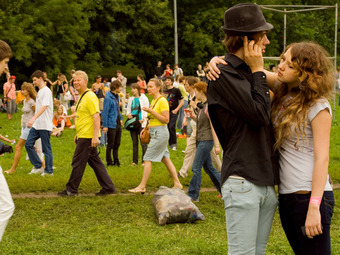
Adolescent Flirtation
Adolescence is a time of social and sexual exploration.
4.7.7: Transitional Adulthood
Coming of age traditions, while different across the world, are seen in almost every society.
Learning Objective
Discuss how a young person “comes of age”, particularly in the context of religion or rituals
Key Points
- In many cultures, the transition from childhood to adulthood is marked by a coming of age tradition. In some, such traditions are associated with the arrival of sexual maturity in early adolescence; in others, it is associated with the arrival of new religious responsibilities.
- Often, coming of age traditions are religious, and signify that the individual is taking on a different role in his or her religious life, such as the Jewish bar mitzvah or Hindu ceremonies celebrating maturity.
- Other times these traditions are secular in nature and can range from legal benefits to extravagant parties.
Key Term
- coming of age
-
A person’s journey from childhood or adolescence to adulthood.
“Coming of age” refers to a young person’s transition from childhood to adulthood. The age at which this transition takes place varies among different societies, as does the nature of the transition. It can be a simple legal convention or can be part of a larger ritual. In some societies today, such changes are associated with the arrival of sexual maturity in early adolescence; in others, it is associated with the arrival of an age at which point one carries religious responsibilities. In western societies, legal conventions stipulate points in late adolescence or early adulthood that mark the age of maturity are the focus of the transition. Still, many cultures retain ceremonies to confirm the coming of age and benefits come with the change.
Religion
Religion is often a determinant of when and how individuals come of age.
When members of the Baha’i faith turn 15, they reach the “age of maturity” and are considered spiritually mature, and are responsible for individually determining whether they wish to remain members of Baha’i. Those who declare that they wish to remain members of Baha’i are expected to begin observing certain Baha’i laws, such as obligatory prayer and fasting.
In many Christian churches, a young person celebrates his or her coming of age with the Sacrament of Confirmation. Some traditions withhold the rite of Holy Communion from those not yet at the age of accountability on the grounds that children do not understand what the sacrament means. In some denominations, full membership in the church, if not bestowed at birth, often must wait until the age of accountability, and is frequently granted only after a period of preparation known as catechesis. The time of innocence before one has the ability to understand truly the laws of God, and during which God sees one as innocent, is also seen as applying to individuals who suffer from a mental disability which prevents them from ever reaching a time when they are capable of understanding the laws of God. These individuals are thus seen as existing in a perpetual state of innocence by the grace of God.
In Hinduism, coming of age generally signifies that a boy or girl are mature enough to understand his responsibility towards family and society. Hinduism also has the sacred thread ceremony for Dvija (twice-born) boys that marks their coming of age to do religious ceremonies. Women often celebrate their coming to age by having a ceremony. This ceremony includes dressing themselves in saris and announcing their maturity to the community
In Islam, children are not required to perform any obligatory acts of Islamic teachings prior to reaching the age of puberty, although they should be encouraged to begin praying at the age of seven. Before reaching puberty it is recommended to pray in obeisance to Allah and to exemplify Islamic customs, but as soon as one exhibits any characteristic of puberty, that person is required to perform the prayers and other obligations of Islam.
In the Jewish faith, boys reach religious maturity at the age of 13, signified by their bar mitzvah ceremony. Girls are believed to mature earlier and can have their bat mitzvah at the age of 12. Once the ritual is done, the new men and women are looked upon as adults and are expected to uphold the Jewish commandments and laws.
Professional Initiatory Rituals
Coming of age initiation rituals can occur in various professional organizations. In many universities of Europe, South America and India, first year students are made to undergo tests or humiliation before being accepted as students. Perhaps the oldest of these is “Raisin Monday,” which is still ongoing is at the University of St. Andrews in Scotland. A senior student will take a new student and show him or her around the university. In gratitude, the new student will give the senior student a pound of raisins, for which the senior student gave receipts. If a new student later fails to produce the receipt that demonstrated his gift upon command, he could be thrown into a fountain.
Universities in Chile follow an annual ritual called “Mechoneo” (the act of pulling somebody’s hair). First year students are initiated by theatrical “punishment. ” Freshmen are tied together while upperclassmen throw them eggs, flour, water, etc. Some universities have traditional ways of initiating freshmen. In the United States, these sorts of initiation rituals are most commonly found in fraternities and sororities. Greek organizations may have different processes for associate members, also known as pledges, to become a member.

Bar Mitzvah
This thirteen-year-old boy is dressed in the religious garb and symbols of the Jewish faith on the day of his bar mitzvah. He is about to be recognized as an adult by the Jewish community.
4.7.8: Marriage and Responsibility
People marry for love, for socioeconomic stability, to start a family, and to create obligations between one another.
Learning Objective
Assess the importance of the institution of marriage, as well as the various reasons why people enter into a marriage
Key Points
- Marriage rituals and traditions have changed significantly over time and vary across cultures.
- Marriage is a personal and sentimental act as well as one that often has religious and legal implications and significance.
- As of 2003, one’s level of educational attainment was a significant predictor of the educational attainment of one’s spouse.
Key Terms
- marriage
-
The union of two (or sometimes more) people, usually to the exclusion of all others.
- same-sex marriage
-
A marriage that unifies two people of the same sex either legally or only symbolically.
- procreation
-
The sexual activity of conceiving and bearing biological offspring.
Marriage is a governmentally, socially, or religiously recognized interpersonal relationship, usually intimate and sexual, that is often created as a form of contract. The most frequently occurring form of marriage is between a woman and a man, where the feminine term wife and the masculine husband are generally used to describe the parties to the contract. Some countries and American states recognize same-sex marriage, but gaining recognition for these unions is a legal battle occurring around the world .

Same-Sex Marriage
In some states and countries, homosexual couples can get legally married.
The ceremony in which a marriage is enacted and announced to the community is called a wedding. The reasons people marry vary widely, but usually include publicly and formally declare their love, the formation of a single household unit, legitimizing sexual relations and procreation, social and economic stability, and the education and nurturing of children. A marriage can be declared by a wedding ceremony, which may be performed either by a religious officiator or through a similar government-sanctioned secular process. The act of marriage creates obligations between the individuals involved and, in some societies, between the parties’ extended families. Marriages are perpetual agreements with legal consequences, terminated only by the death of one party or by formal dissolution processes, such as divorce and annulment.
Schwartz and Mare examined trends in marriage over time and found that the old maxim “opposites attract” is less accurate of marriage than the maxim “birds of a feather flock together. ” Their research focused on one specific similarity in marital partners: education. They found that the correlation of educational levels of American married couples decreased in similarity slightly after World War II, but has since increased substantially. As of 2003, one’s level of educational attainment was a significant predictor of the educational attainment of one’s spouse. People without a high school diploma are unlikely to marry someone with more educational attainment and people with a college degree are likely to marry people with a similar level of educational attainment. Part of the reason why education is so influential in determining the level of education of one’s spouse is because people tend to form groups based on levels of education. First, there are the groups formed in the process of becoming educated; many people meet their spouses at school. But jobs after one completes his or her education also tend to be grouped by level of education. As a result, people spend more time with individuals of a similar level of educational attainment. As most people tend to marry or partner with individuals with whom they spend a lot of time, it is not surprising that there is significant educational similarity between spouses.
One well-known attribute of marriage is that it tends to have health benefits. Happily married people tend to be healthier than unmarried people. However, unhappily married couples may not receive the same health benefits and may actually be less healthy than their single peers.

Wedding
In many countries, heterosexual weddings have the women dress in traditional white with a veil and the men in a tuxedo.
4.7.9: The Middle Years
Middle adulthood is generally accompanied by a decline in physical health and fertility, and an increase in ability to cope with stress.
Learning Objective
Discuss the implications of middle age in terms of fading physical health and mortality concerns
Key Points
- There is much debate over the definition of the period in a person’s life called “middle years” or “middle adulthood,” but is generally thought to be experienced between the ages of 40 and 65.
- During this time, health begins to decline, but the middle-aged benefit from greater life experiences and less volatile responses to stress.
- Both male and female fertility begin to decline with middle age. Additionally, in developed countries, mortality begins to increase more noticeably each year from age 40 onwards.
Key Terms
- middle age
-
The period of life between youth and old age; midlife.
- aging
-
The process of becoming older or more mature.
- advanced maternal age
-
Increases the risk of a child being born with some disorders, such as Down syndrome.
Middle age is the period of age beyond young adulthood but before the onset of old age. Various attempts have been made to define this age, which is around the third quarter of the average life span. The U.S. Census lists middle age as including people aged from 35 to 54, while developmental psychologist Erik Erikson argues that middle adulthood occurs from the age of 40 until 65.
Middle-aged adults often show visible signs of aging such as the loss of skin elasticity and the graying of hair. Physical fitness usually wanes, with a 5–10 kg (10-20 lb) accumulation of body fat, reduction in aerobic performance and a decrease in maximal heart rate. Strength and flexibility also decrease throughout middle age. However, people age at different rates and there can be significant differences between individuals of the same age.
Both male and female fertility declines with advancing age. Advanced maternal age increases the risk of a child being born with some disorders, such as Down syndrome. Advanced paternal age sharply increases the risk of miscarriage, as well as Down syndrome, schizophrenia, autism, and bipolar disorder. Middle aged women will experience menopause, which ends natural fertility, in their late 40s or early 50s.
In developed countries, mortality begins to increase more noticeably each year from age 40 onwards, mainly due to age-related health problems, such as heart disease and cancer. However, the majority of middle-age people in industrialized nations can expect to live into old age. In general, life expectancy in developing countries is much lower and the risk of death at all ages is higher.
However, well-being involves more than merely physical factors, and middle age is not experienced as a “time of decline” for healthy people. Middle-aged people benefit from greater life experience than they had when they were young; this contributes to happiness and makes emotional responses to stress less volatile.

Middle Age
Diana DeGette, a politician from Colorado, was born in 1957 and is in the middle age stage of life.
4.7.10: Parenthood
Parenting is the process of supporting the physical, emotional, social, and intellectual development of a child from infancy to adulthood.
Learning Objective
Contrast the four parenting styles: authoritarian, authoritative, permissive, and uninvolved
Key Points
- Parenting is defined by a range of different skills and styles. It is also a continuously changing process as the child grows and develops.
- Parenting challenges and techniques transform continuously over the lifespan of a child.
- Parenting is guided by different philosophies and practices, which inform parenting styles and family structure.
- Developmental psychologist Diana Baumrind identified three main parenting styles in early child development; these were later expanded to four: authoritarian, authoritative, permissive, and uninvolved.
- It is important to realize that parenting doesn’t end when a child turns 18. Support is needed in a child’s life well beyond the adolescent years and continues into middle and later adulthood.
Key Terms
- authoritarian parenting style
-
Parenting styles can be very rigid and strict. Parents who practice authoritarian style parenting have a strict set of rules and expectations and require rigid obedience.
- family planning
-
Birth control, especially when carried out by monogamous heterosexual couples.
- parenting
-
Process of raising and educating a child from birth until adulthood.
Parenting is the process of promoting and supporting the physical, emotional, social, and intellectual development of a child from infancy to adulthood. Parenting refers to the aspects of raising a child aside from the biological relationship. Parenting is usually carried out by the biological parents of the child in question, although governments and society take a role as well.
Social class, wealth, and income have the strongest impact on what methods of child rearing parents use. Understanding parenting styles help us understand how those styles contribute to the behavior and development of children.
Parenting Styles
Developmental psychologist Diana Baumrind identified three main parenting styles in early child development: authoritarian, authoritative, and permissive. These parenting styles were later expanded to four, including an uninvolved style. These four styles of parenting involve combinations of acceptance and responsiveness on the one hand, and demand and control on the other.
- Authoritarian parenting styles can be very rigid and strict. If rules are not followed, punishment is most often used to ensure obedience. There is usually no explanation for punishment except that the child is in trouble and should listen accordingly.
- Authoritative parenting relies on positive reinforcement and infrequent use of punishment. Parents are more aware of a child’s feelings and capabilities, and they support the development of a child’s autonomy within reasonable limits. There is a give-and-take atmosphere involved in parent-child communication, and both control and support are exercised in authoritative parenting.
- Permissive or Indulgent parenting is most popular in middle class families in Western culture. In these family settings, a child’s freedom and autonomy are valued and parents tend to rely mostly on reasoning and explanation. There tends to be little if any punishment or rules in this style of parenting and children are said to be free from external constraints.
- An uninvolved parenting style is when parents are often emotionally absent and sometimes even physically absent. They have no little to no expectation of the child and regularly have no communication. They are not responsive to a child’s needs to do not demand anything of them in their behavioral expectations.
There is no single or definitive model of parenting. What may be right for one family or one child may not be suitable for another, although research shows that the authoritative parenting style is extremely effective and yields self-reliant, cheerful, and friendly children.
Various Parenting Practices
- Attachment Parenting: working strengthen the intuitive, psychological, and emotional bond between the primary caregiver and the child
- Helicopter Parenting: over-parenting; parents are constantly involving themselves, interrupting the child’s ability to function on their own
- Narcissistic Parenting: parents are driven by their own needs; their children are an extension of their own identity; use their children to live out their dreams
- Positive Parenting: unconditional support, guiding them and supporting them for healthy development
- Slow Parenting: allowing the child to develop their own interests and allowing them to grow into their own person; lots of family time; allowing children to make their own decisions; limit electronics, simplistic toys
- Spiritual Parenting: respecting the child’s individuality; making space for child to develop a sense of their own beliefs through their personality and their own potentials
- Strict Parenting: focused on strict discipline; demanding, with high expectations from the parents
- Toxic Parenting: poor parenting; complete disruption of the child’s ability to identify one’s self and reduced self-esteem; neglecting the needs of the child and abuse is sometimes seen in this parenting style
- Unconditional Parenting: giving unconditional positive encouragement
Parenting across the Lifespan
Family planning is the decision whether and when to become parents, including planning, preparing, and gathering resources. Parents should assess whether they have the required financial resources (the raising of a child costs around $16,198 yearly in the United States). They should also assess whether their family situation is stable enough and whether they themselves are responsible and qualified enough to raise a child. Reproductive health and preconceptional care affect pregnancy, reproductive success, and maternal and child physical and mental health. During pregnancy, the unborn child is affected by many decisions that his or her parents make, particularly choices linked to their lifestyle. The health and diet decisions of the mother can have either a positive or negative impact on the child in utero.
It is important to realize that parenting doesn’t end when a child turns 18. Support is needed in a child’s life well beyond the adolescent years and continues into middle and later adulthood. Parental support is crucial in helping children figure out who they are and where they fit in the world. Parenting is a lifelong process.
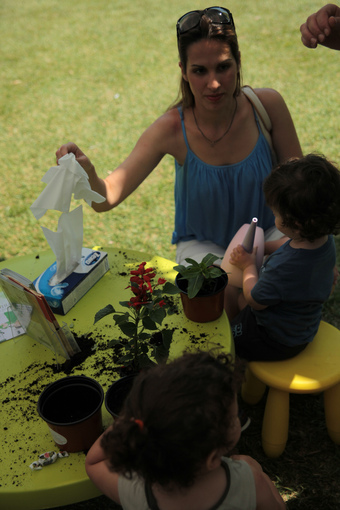
Parenting
Parents have to tend more to children’s basic needs when they are young.
4.7.11: Career Development: Vocation and Identity
A vocation is an occupation to which an individual is particularly drawn.
Learning Objective
Define the meaning of the word “vocation” and how it impacts the choices people make as far as occupations are concerned
Key Points
- The word “vocation” is often used in a Christian religious context where a vocation is a call by God to the individual.
- A person’s vocation is a profession that helps define a person’s identity and directs a person’s interests.
- Since the origination of Vocational Guidance in 1908, by the engineer Frank Parsons, the use of the term ‘vocation’ has evolved to include the notion of using our talents and capabilities to good-effect in choosing and enjoying a career.
Key Terms
- career
-
One’s calling in life; a person’s occupation; one’s profession.
- vocation
-
An occupation for which a person is suited, trained, or qualified.
Example
- Any profession, such as a doctor, lawyer, or social worker, is an example of a vocation.
A vocation is a term for an occupation to which a person is especially drawn or for which he or she is suited, trained, or qualified. Though now often used in non-religious contexts, the meanings of the term originated in Christianity.
Use of the word “vocation” before the sixteenth century referred firstly to the “call” by God to the individual, or calling of all humankind to salvation, particularly in the Vulgate, and more specifically to the “vocation to the priesthood,” which is still the usual sense in Roman Catholicism.
The idea of vocation is central to the Christian belief that God has created each person with gifts and talents oriented toward specific purposes and a way of life. This idea of vocation is especially associated with a divine call to service to the Church and humanity through particular vocational life commitments, such as marriage to a particular person, consecration as a religious, ordination to priestly ministry in the Church, and even a holy life as a single person. In the broader sense, Christian vocation includes the use of one’s gifts in their profession, family life, church, and civic commitments for the sake of the greater common good.
Since the origination of Vocational Guidance in 1908, by the engineer Frank Parsons, the use of the term “vocation” has evolved to include the notion of using our talents and capabilities to good effect in choosing and enjoying a career. This semantic expansion has meant some diminishment of reference to the term’s religious meanings in everyday usage.

Professional Vocations
In common parlance, a vocation refers to one’s professional line of work or career, such as being a doctor.
4.7.12: The Older Years
Old age cannot be exactly defined, but it is often associated with certain activities, such as becoming a grandparent or entering retirement.
Learning Objective
Discuss some of the implications of old age, particularly in relation to Erikson’s “Eight Stages of Life” and age discrimination
Key Points
- Erik Erikson characterizes old age as a period of “Integrity vs. Despair,” during which a person focuses on reflecting back on their life. Those who are unsuccessful during this phase will feel that their life has been wasted and will experience many regrets.
- Those who feel proud of their accomplishments will feel a sense of integrity. Successfully completing this phase means looking back with few regrets and a general feeling of satisfaction.
- Old age presents some social problems, such as age discrimination. Elderly people are more likely to be victims of abuse, and negative stereotypes are also very common.
Key Terms
- self-neglect
-
It refers to behaviors that threaten the person’s own health and safety.
- abuse
-
Physical or verbal maltreatment; injury.
Example
- An example of self-neglect would be an elderly person who forgets to take his medication. An example of a stereotype of an elderly people is that they are weak and incapable.
The boundary between middle age and old age cannot be defined exactly because it does not have the same meaning in all societies. People can be considered old because of certain changes in their activities or social roles. For example, people may be considered old when they become grandparents, or when they begin to do less or different work (retirement). Traditionally, the age of 60 was generally seen as the beginning of old age. Most developed world countries have accepted the chronological age of 65 years as a definition of an “elderly” or older person.
According to Erik Erikson’s “Eight Stages of Life” theory, the human personality is developed in a series of eight stages that take place from the time of birth and continue on throughout an individual’s complete life. He characterizes old age as a period of “Integrity vs. Despair,” during which a person focuses on reflecting back on their life. Those who are unsuccessful during this phase will feel that their life has been wasted and will experience many regrets. The individual will be left with feelings of bitterness and despair. Those who feel proud of their accomplishments will feel a sense of integrity. Successfully completing this phase means looking back with few regrets and a general feeling of satisfaction. These individuals will attain wisdom, even when confronting death.
Age discrimination is a prevalent social problem facing the elderly. While discrimination toward the young is primarily visible through behavioral restrictions, discrimination toward the elderly ranges from behavioral restrictions to physical abuse. Abuse of the elderly is a serious problem in the U.S. There are nearly two million cases of elder abuse and self-neglect in the U.S. every year. Abuse refers to psychological/emotional abuse, physical abuse, sexual abuse, and caregiver neglect or financial exploitation, while self-neglect refers to behaviors that threaten the person’s own health and safety.
4.7.13: Are We Prisoners of Socialization?
Who we are as people is determined by both our genes (nature) and our socialization (nurture).
Learning Objective
Discuss socialization in terms of the nature (biology) versus nurture (social) debate
Key Points
- Some experts assert that who we are is a result of nurture—the relationships and caring that surround us—while others argue that who we are is based entirely in genetics, or “nature.”
- Twin studies can provide useful insight into how much a certain trait is due to nurture vs. nature.
- Research demonstrates that who we are is affected by both nature (our genetic and hormonal makeup) and nurture (the social environment in which we are raised). Sociology is most concerned with the way that society’s influence affects our behavior patterns, made clear by the way behavior varies across class and gender.
Key Term
- socialization
-
The process of learning one’s culture and how to live within it.
Some experts assert that who we are is a result of nurture—the relationships and caring that surround us. Others argue that who we are is based entirely in genetics. According to this belief, our temperaments, interests, and talents are set before birth. From this perspective, then, who we are depends on nature.
One way that researchers attempt to prove the impact of nature is by studying twins. Some studies followed identical twins who were raised separately. The pairs shared the same genetics, but, in some cases, were socialized in different ways. Instances of this type of situation are rare, but studying the degree to which identical twins raised apart are the same and different can give researchers insight into how our temperaments, preferences, and abilities are shaped by our genetic makeup versus our social environment.
For example, in 1968, twin girls born to a mentally ill mother were put up for adoption. However, they were also separated from each other and raised in different households. The parents, and certainly the babies, did not realize they were one of five pairs of twins who were made subjects of a scientific study (Flam 2007).
In 2003, the two women, then age 35, reunited. Elyse Schein and Paula Bernstein sat together in awe, feeling like they were looking into a mirror. Not only did they look alike, but they behaved alike, using the same hand gestures and facial expressions (Spratling 2007). Studies like these point to the genetic roots of our temperament and behavior.
Though genetics and hormones play an important role in human behavior, sociology’s larger concern is the effect that society has on human behavior, the “nurture” side of the nature versus nurture debate. What race were the twins? From what social class were their parents? What about gender? Religion? All of these factors affect the lives of the twins as much as their genetic makeup and are critical to consider as we look at life through the sociological lens.

Nature or Nurture?
“Nature versus nurture” describes the debate over the influence of biological versus social influences in socialization.
Sociologists all recognize the importance of socialization for healthy individual and societal development. But how do scholars working in the three major theoretical paradigms approach this topic? Structural functionalists would say that socialization is essential to society, both because it trains members to operate successfully within it and because it perpetuates culture by transmitting it to new generations. Without socialization, a society’s culture would perish as members died off. A conflict theorist might argue that socialization reproduces inequality from generation to generation by conveying different expectations and norms to those with different social characteristics. For example, individuals are socialized differently by gender, social class, and race. As in the illustration of Chris Langan, this creates different (unequal) opportunities. An interactionist studying socialization is concerned with face-to-face exchanges and symbolic communication. For example, dressing baby boys in blue and baby girls in pink is one small way that messages are conveyed about differences in gender roles.
Socialization is important because it helps uphold societies and cultures; it is also a key part of individual development. Research demonstrates that who we are is affected by both nature (our genetic and hormonal makeup) and nurture (the social environment in which we are raised). Sociology is most concerned with the way that society’s influence affects our behavior patterns, made clear by the way behavior varies across class and gender.
4.8: Childhood Socialization
4.8.1: Child Socialization
Primary and secondary socialization are two forms of socialization that are particularly important for children.
Learning Objective
Justify the importance of socialization for children, in terms of both primary and secondary socialization
Key Points
- Socialization refers to the lifelong process of inheriting and disseminating norms, customs, and ideologies, providing an individual with the skills and habits necessary for participating within his or her own society.
- Primary socialization for a child is very important because it sets the groundwork for all future socialization.
- Primary socialization occurs when a child learns the attitudes, values, and actions appropriate to individuals as members of a particular culture.
- Secondary socialization refers to the process of learning what is the appropriate behavior as a member of a smaller group within the larger society.
- Sigmund Freud’s psychosexual stages describe the progression of an individual’s unconscious desires.
- Lawrence Kohlberg’s stages of moral development describe how individuals develop in and through reasoning about morals.
- Jane Loevinger developed a theory with stages of ego development.
- Margaret Mahler’s psychoanalytic developmental theory contained three phases regarding the child’s object relations.
- Jean Piaget’s theory of cognitive development describes how children reason and interact with their surroundings.
- James Marcia’s theory focuses on identity achievement and has four identity statuses.
Key Terms
- primary socialization
-
Primary socialization in sociology is the acceptance and learning of a set of norms and values established through the process of socialization.
- secondary socialization
-
Secondary socialization refers to the process of learning what is the appropriate behavior as a member of a smaller group within the larger society.
- socialization
-
Socialization is the process of transferring norms, values, beliefs, and behaviors to future group members.
Socialization is a term used by sociologists, social psychologists, anthropologists, political scientists, and educationalists to refer to the lifelong process of inheriting and disseminating norms, customs, and ideologies, providing an individual with the skills and habits necessary for participating within his or her own society. Socialization is thus “the means by which social and cultural continuity are attained. ” There are many different forms of socialization, but two types are particularly important for children. These two types are known as primary and secondary socialization.
Primary socialization in sociology is the acceptance and learning of a set of norms and values established through the process of socialization. Primary socialization for a child is very important because it sets the groundwork for all future socialization. Primary socialization occurs when a child learns the attitudes, values, and actions appropriate to individuals as members of a particular culture. It is mainly influenced by the immediate family and friends. For example if a child saw his or her mother expressing a discriminatory opinion about a minority group, then that child may think this behavior is acceptable and could continue to have this opinion about minority groups.
Secondary socialization refers to the process of learning what is the appropriate behavior as a member of a smaller group within the larger society. Basically, it is the behavioral patterns reinforced by socializing agents of society. Secondary socialization takes place outside the home. It is where children and adults learn how to act in a way that is appropriate for the situations they are in . Schools require very different behavior from the home, and children must act according to new rules. New teachers have to act in a way that is different from pupils and learn the new rules from people around them. Secondary socialization is usually associated with teenagers and adults, and involves smaller changes than those occurring in primary socialization.
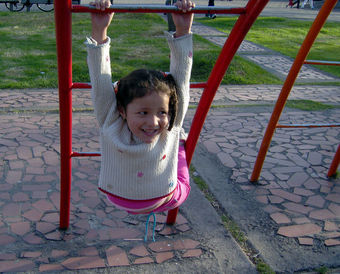
Girl on a Playground
Playgrounds and other social situations contribute to secondary child socialization.
4.8.2: Theoretical Perspectives on Childhood Socialization
Theories of childhood socialization and development study the elements of the cognitive and social development that occur in childhood.
Learning Objective
Contrast the various theories of childhood development, such as Freud’s psychosexual theory, Piaget’s stages of development and ecological systems theory
Key Points
- Childhood is a unique time period of accelerated development and has been studied by many theorists.
- Sigmund Freud developed a psychosexual theory of human development that describes how sexual fixation and satisfaction moves psychological development forward.
- Jean Piaget developed a theory of cognitive development that explains how children learn differently at different stages in development.
- Urie Bronfenbrenner developed ecological systems theory that explains how human development is influenced by the context of the developing child.
Key Terms
- Ecological Systems Theory
-
Ecological systems theory, also called development in context or human ecology theory, specifies four types of nested environmental systems, with bi-directional influences within and between the systems.
- Theory of Cognitive Development
-
Piaget’s theory of cognitive development posits that children learn by actively constructing knowledge through hands-on experience.
- Psychosexual Theory of Human Development
-
This theory is divided into five stages, each association with sexual satisfaction through a particular body part.
Since the nineteenth century, childhood has been perceived as a unique phase in an individual’s life, and sociological theories reflect this. The main theories that psychologists and social scientists rely on today were developed in the twentieth century and beyond. These theories seek to understand why childhood is a unique period in one’s life and the elements of the cognitive and social development that occur in childhood. This chapter seeks to give a brief introduction to various theoretical perspectives on childhood.
Twentieth-century Austrian psychologist Sigmund Freud was one of the first psychologists to theorize childhood and the significance of developmental stages. Freud believed that sexual drive, or libido, was the driving force of all human behavior and, accordingly, developed a psychosexual theory of human development. Children progress through five stages, each association with sexual satisfaction through a particular body part.
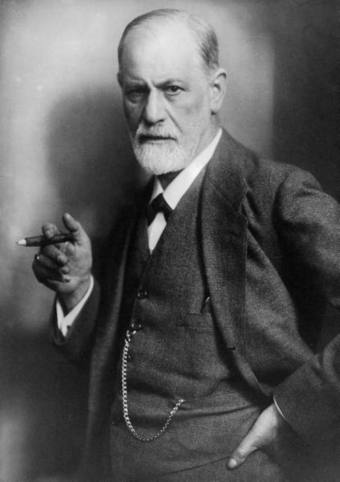
Sigmund Freud
Sigmund Freud developed the psychosexual theory of human development.
One of the most widely applied theories of childhood is Jean Piaget’s theory of cognitive development. Piaget posited that children learn actively through play. He suggested that the adult’s role in helping a child learn is to provide appropriate materials for the child to interact and construct. He encouraged adults to make childhood learning through play even more effective by asking the child questions to get them to reflect upon behaviors. He believed it was instructive for children to see contradictions in their explanations. His approach to childhood development has been embraced by schools, and the pedagogy of preschools in the United States.
Piaget’s Four Stages of Development
Piaget outlined four stages in one’s development to adulthood:
- The first of Piaget’s stages of development is the sensorimotor stage, which lasts from birth until about age two. During this stage, the child learns about himself and his environment through motor and reflex actions. The child learns that he is separate from his environment and that aspects of his environment, such as his parents or a toy, continue to exist even though they may be outside of his sensory field. This observation is called object permanence.
- The sensorimotor stage is followed by the preoperational stage, which begins about the time that the child begins to talk and lasts until about age seven. The developments associated with the preoperational phase all extend from the child learning how to deploy his new linguistic capabilities. The child begins to use symbols to represent objects. Children absorb information and fit it into preexisting categories in their minds.
- Next, children progress to the concrete operational phase, which lasts from about first grade to early adolescence. During this stage, children more easily accommodate ideas that do not fit their preexisting worldview. The child begins to think abstractly and make rational decisions based on observable or concrete phenomena.
- Finally, children enter the formal operational stage, which begins in adolescence and carries them through adulthood. This person no longer requires concrete objects to make rational judgements and is capable of hypothetical and deductive reasoning.
Ecological Systems Theory
In 1979, psychologist Urie Bronfenbrenner published The Ecology of Human Development, setting forth his theory known as ecological systems theory. Also called development in context theory or human ecology theory, the ecology systems theory specifies five different types of nested environmental systems: the microsystem, the mesosystem, the exosystem, the macrosystem, and the chronosystem. Each of these systems exerts influence on an individual, particularly children as they are robustly socialized.
- The microsystem refers to the institutions and groups that most immediately and directly impact the child’s development, including the child’s family, school, religious institution, neighborhood, and peer group.
- The mesosystem recognizes that no microsystem can be entirely discrete and refers to the relationship between microsystems. For example, a child who has been completely abandoned by his family might find it difficult to bond with teachers.
- The exosystem describes the link between a social setting in which the individual does not have an active role an the individual’s immediate context. For example, a child’s experience at home may be impacted by a mother’s experience at work.
- The macrosystem refers to the culture in which individuals live. A child, his school, and his parents are all part of a cultural context whose constituents are united by a sense of common identity, heritage, and values. Microsystems, and therefore mesosystems and exosystems, are impossible to understand when divorced from their macrosystemic context.
- The chronosystem refers to the patterning of environmental events and transitions over one’s life course, as well as broader sociohistorical developments. For example, the impact of divorces on children has varied over history. When divorce was more culturally stigmatized, it had a different effect on children than today, when many children have divorced parents.
4.8.3: Identity Formation
Identity formation is the development of an individual’s distinct personality by which he or she is recognized or known.
Learning Objective
Discuss the formation of a person’s identity, as well as the ideas of self-concept and self-consciousness
Key Points
- Cultural identity is the feeling of identity with a group or culture, or of an individual as far as he or she is influenced by his or her belonging to a group or culture.
- An ethnic identity is an identification with a certain ethnicity, usually on the basis of a presumed common genealogy or ancestry.
- National identity is an ethical and philosophical concept whereby all humans are divided into groups called nations.
- A religious identity is the set of beliefs and practices generally held by an individual, involving adherence to codified beliefs and rituals and study of ancestral or cultural traditions.
- Self-concept is the sum of a being’s knowledge and understanding of his or her self.
- Cultural identity is the feeling of identity of a group or culture, or of an individual as far as he or she is influenced by his or her belonging to a group or culture.
- An ethnic identity is the identification with a certain ethnicity, usually on the basis of a presumed common genealogy or ancestry.
- National identity is an ethical and philosophical concept whereby all humans are divided into groups called nations.
- A religious identity is the set of beliefs and practices generally held by an individual, involving adherence to codified beliefs and rituals and study of ancestral or cultural traditions
Key Terms
- religious identity
-
The set of beliefs and practices generally held by an individual,involving adherence to codified beliefs and rituals and study of ancestral or cultural traditions, writings, history, and mythology, as well as faith and mystic experience.
- cultural identity
-
One’s feeling of identity affiliation to a group or culture.
- national identity
-
An ethical and philosophical concept whereby all humans are divided into groups called nations.
Example
- An example of national identity is the way in which Americans are united on the Fourth of July. In celebrating national independence, one feels a connection to all other Americans. Indeed, the holiday would make little sense if one did not possess a sense of national identity. An example of religious identity would be if someone identifies as belonging to a particular religious faith.
Identity formation is the development of an individual’s distinct personality, which is regarded as a persisting entity in a particular stage of life by which a person is recognized or known. This process defines individuals to others and themselves. Pieces of the individual’s actual identity include a sense of continuity, a sense of uniqueness from others, and a sense of affiliation. Identity formation clearly influences personal identity by which the individual thinks of him or herself as a discrete and separate entity. This may be through individuation whereby the undifferentiated individual tends to become unique, or undergoes stages through which differentiated facets of a person’s life tend toward becoming a more indivisible whole.
Individuals gain a social identity and group identity by their affiliations. Self-concept is the sum of a being’s knowledge and understanding of himself. Self-concept is different from self-consciousness, which is an awareness of one’s self. Components of self-concept include physical, psychological, and social attributes, which can be influenced by the individual’s attitudes, habits, beliefs, and ideas. Cultural identity is one’s feeling of identity affiliation to a group or culture.
Similarly, an ethnic identity is the identification with a certain ethnicity, usually on the basis of a presumed common genealogy or ancestry. Further, national identity is an ethical and philosophical concept whereby all humans are divided into groups called nations. Members of a nation share a common identity and usually a common origin in their sense of ancestry, parentage, or descent. Lastly, a religious identity is the set of beliefs and practices generally held by an individual, involving adherence to codified beliefs and rituals and study of ancestral or cultural traditions, writings, history, and mythology, as well as faith and mystic experience.
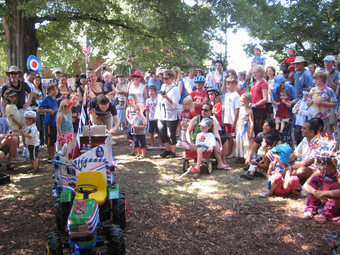
National Identity
Fourth of July celebrations, during which Americans dress in red, white, and blue, are manifestations of national identity. Fourth of July is only meaningful as a celebration of independence for individuals who share a sense of national identity as Americans.
